You got the story of a perfect day trip here to the Matsu archipelago here and there
Now is the story when it goes wrong, both on the way in here and on the return flight. (This FR was originally posted in my native French).
This time, I went to Taipei's domestic airport to buy my plane tickets for this small trip to the Matsu archipelago, which gave me an excuse to go plane spotting afterwards. Now I know (and my readers too) that at TSA, you buy the plane tickets at the check-in counter. Same for paying tickets booked over the phone, because Taiwan is a strange country where you can book plane tickets without even providing a credit card number. The staff here was actually surprised that I wanted to pay the tickets immediately.
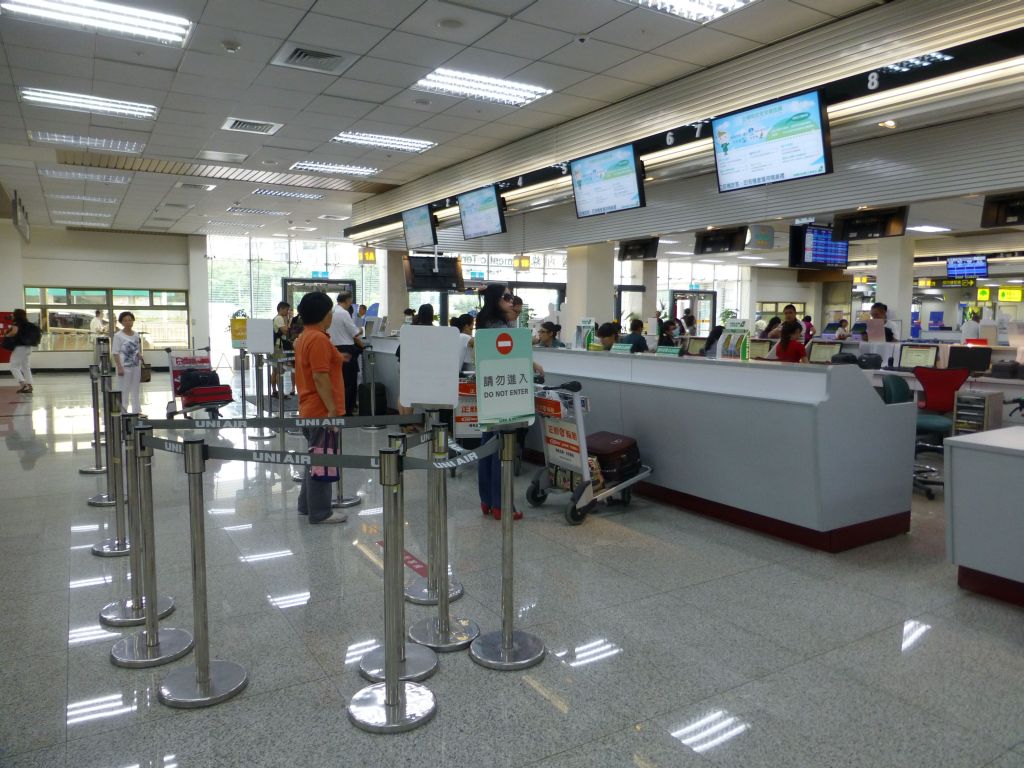
It would arguably have been faster on the internet, because providing a resident card and the photocopy of a foreign passport, with strange looooong names which never fit in the space for the Taiwanese three (exceptionally four) ideogram names, did not simplify matters.
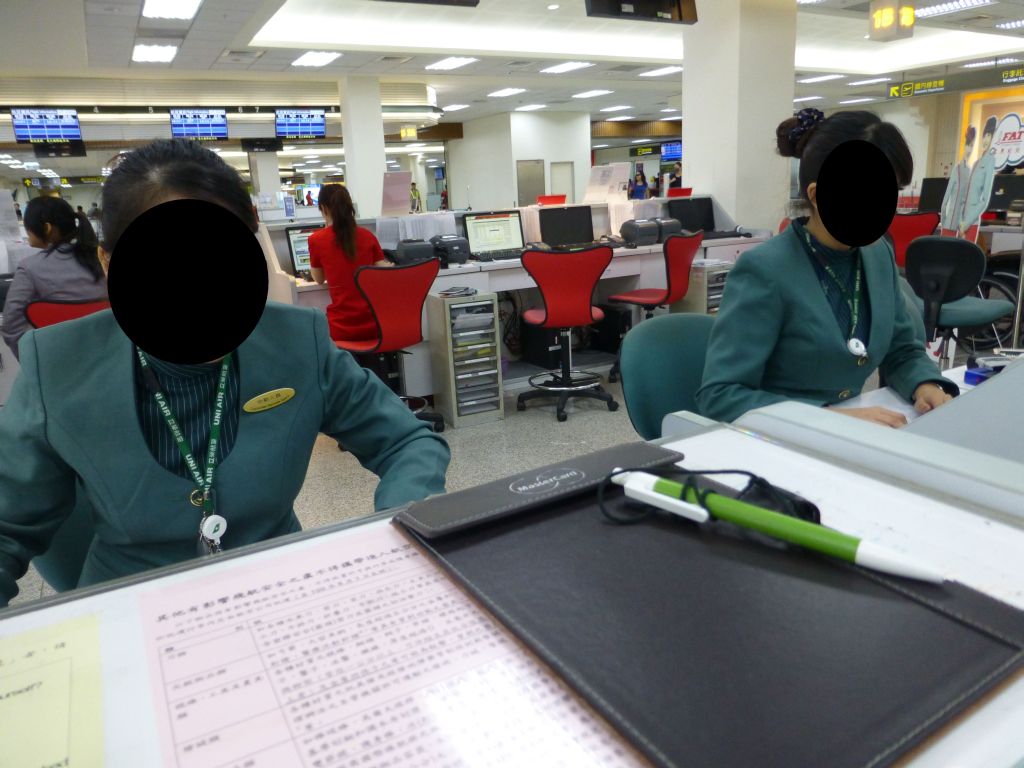
On the other hand, no problem on D Day to check in and get a left side window seat. Exceptionally, this is an aisle seat FR, because I gave the window seat to my wife to give her the best view on the mess to come.
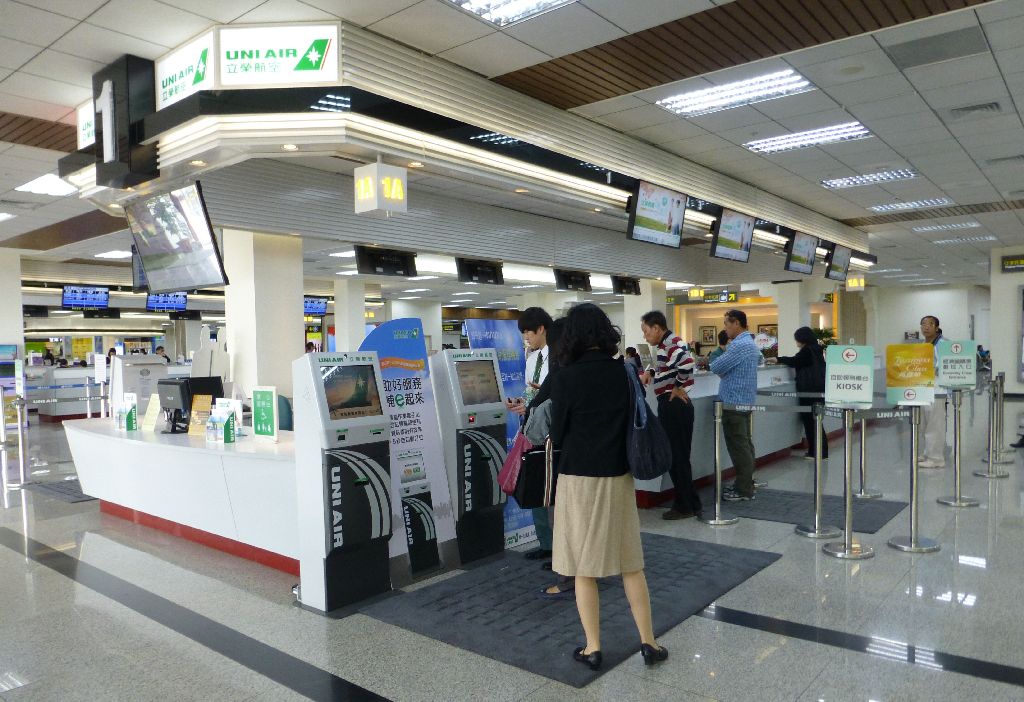
Four Uni-Air flights out of five are booked full in the coming hours.
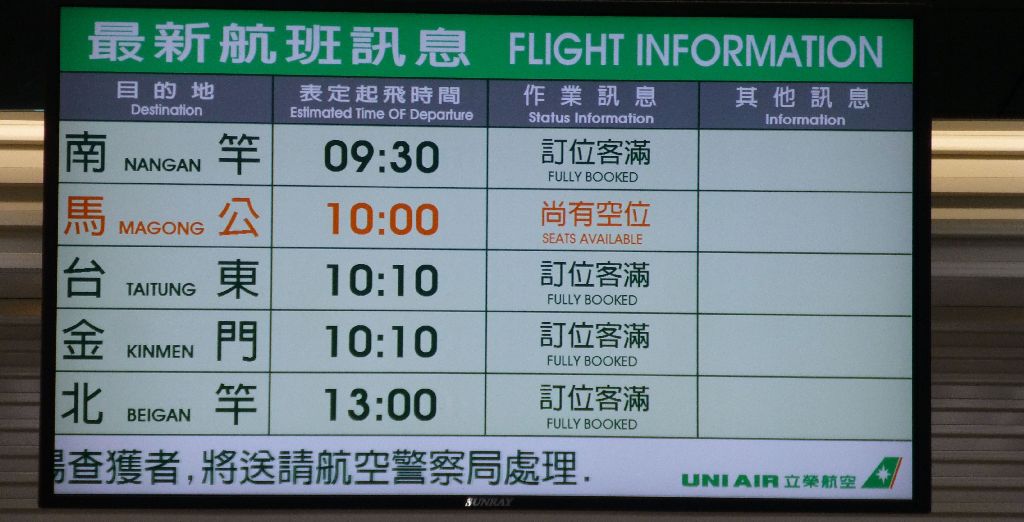
Another rarity in my Taiwanese domestic flights: having a checked luggage, which is not an exciting experience.

The Taiwanese really have a problem with the transcription of Chinese in the Latin alphabet: I have never seen Matsu transcribed in such a creative manner, on this diminutive checked luggage receipt, shown on both sides here.

There are far many more people in the landside armchair than at the time of the earlier flights.

My laptop's screen lighting is weak when it works on its battery, but the free wifi allows me to have a traditional corporate screenshot in this FR.

What seem to be sales counters only manage the waiting lists. Passengers write their names on these pages, in the foreground, on per destination.
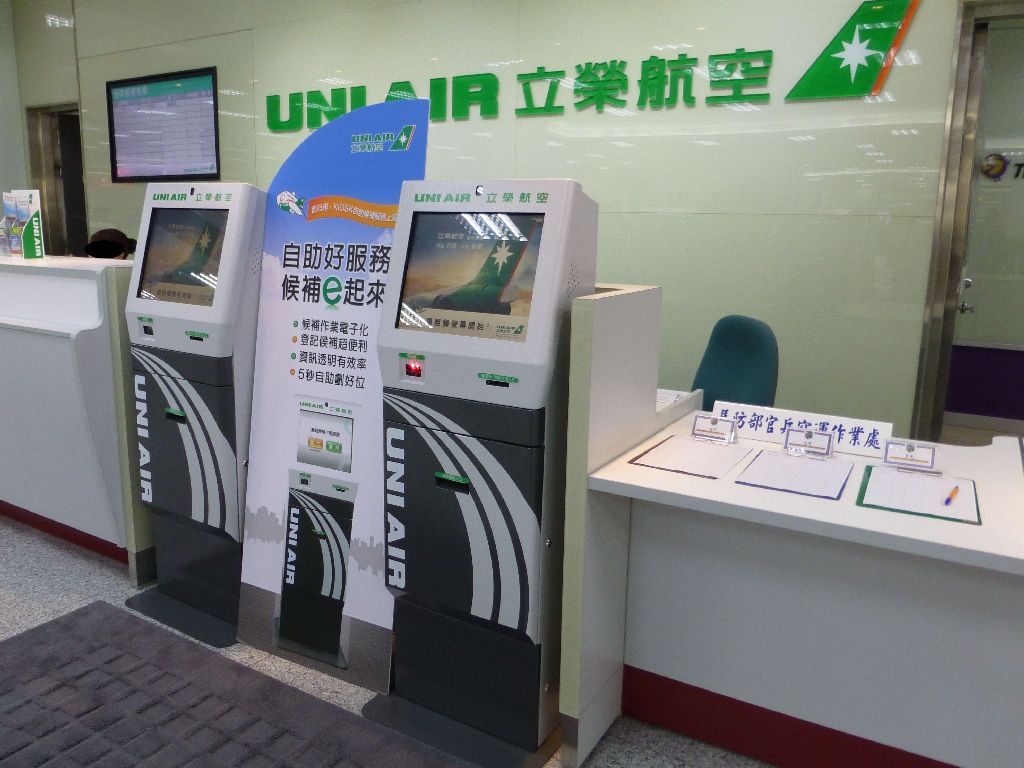
The waiting list is then displayed on the screen, destination per destination. From left to right: the waiting list number, the partially masked national ID number and the full name. There were only two names on the waiting list for LZN. No-shows are commonplace in Taiwan, because there is no penalty for that, and my educated guess is that Mr. Chen Jin-yuan and Mrs. Mme Xu Jia-peng got a last minute seat.
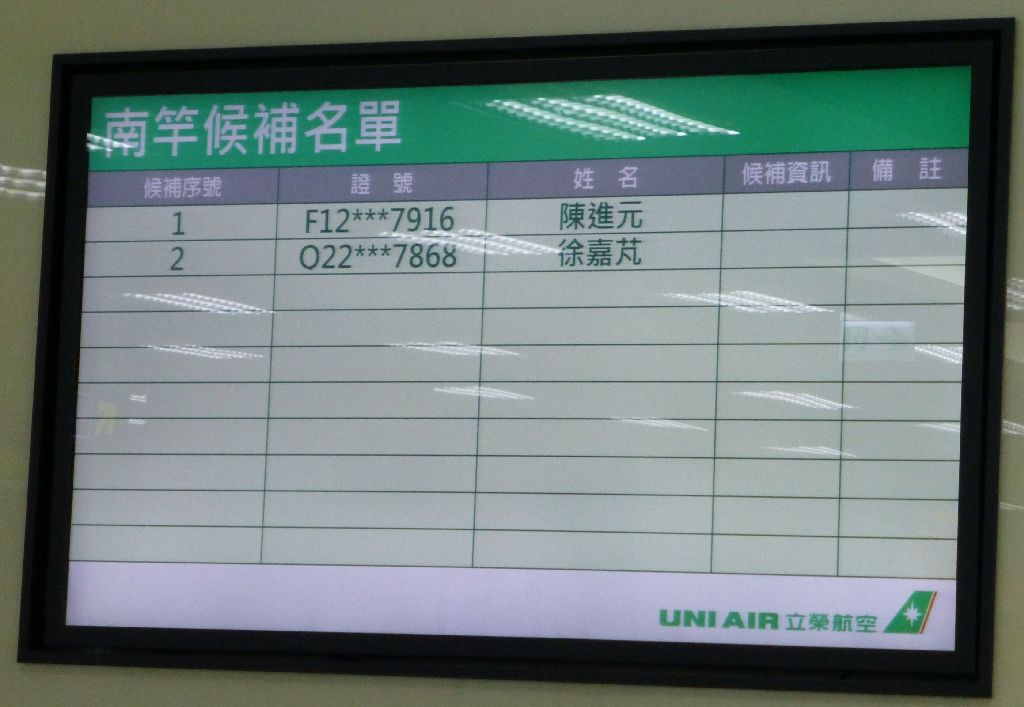
A group checking in their luggage at Uni-Air. My educated guess is that they are on the flight to Kinmen, which is the cheap gateway by ferry to Mainland China for the Taiwanese.
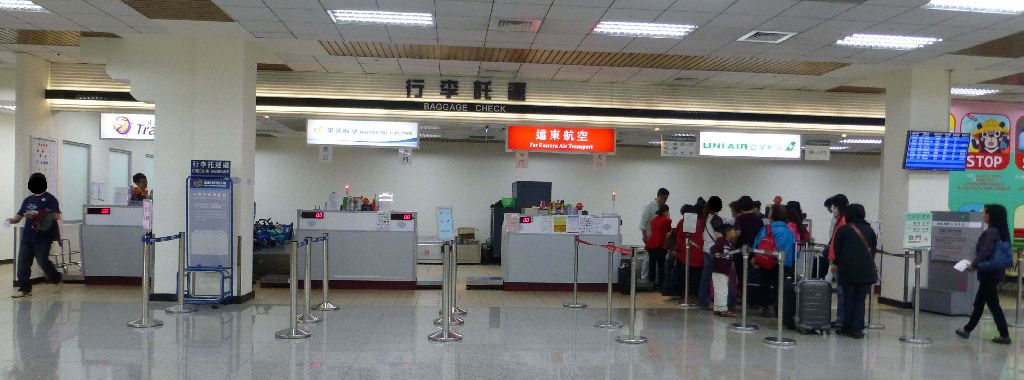
Security check without any problem, and I reach the boarding room which did not change since two weeks earlier.
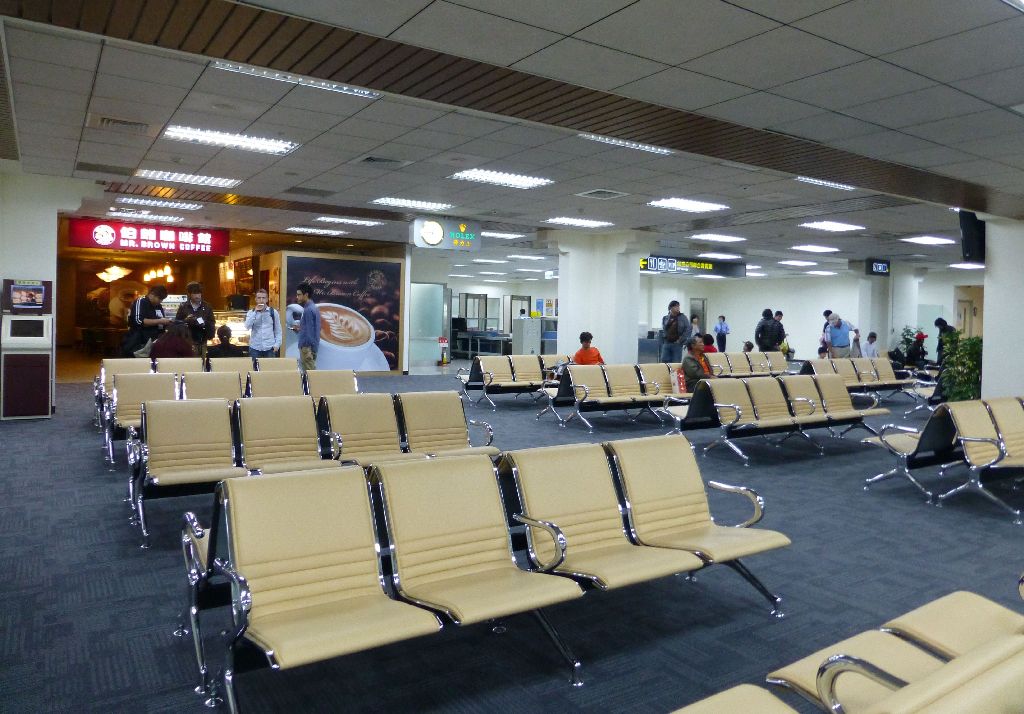
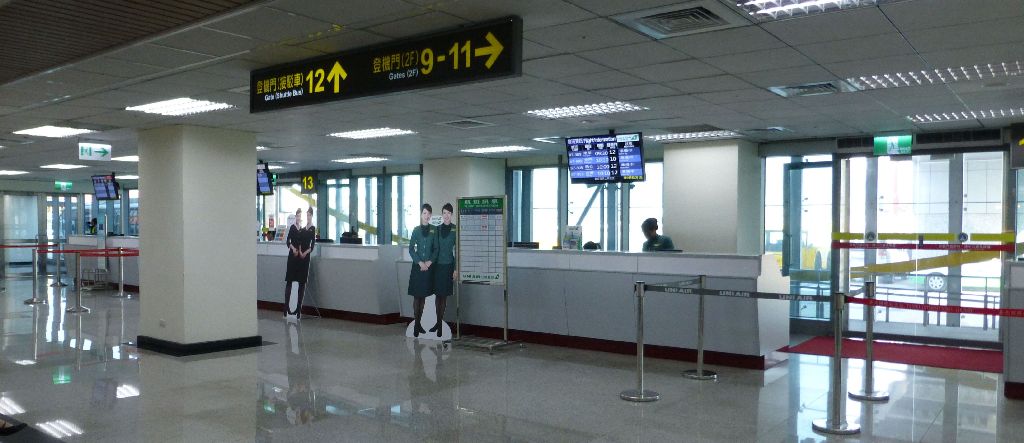
TSA even delivers me a red carpet welcome to plane spotting in the upper level, that of the jetbridge boarding gates.
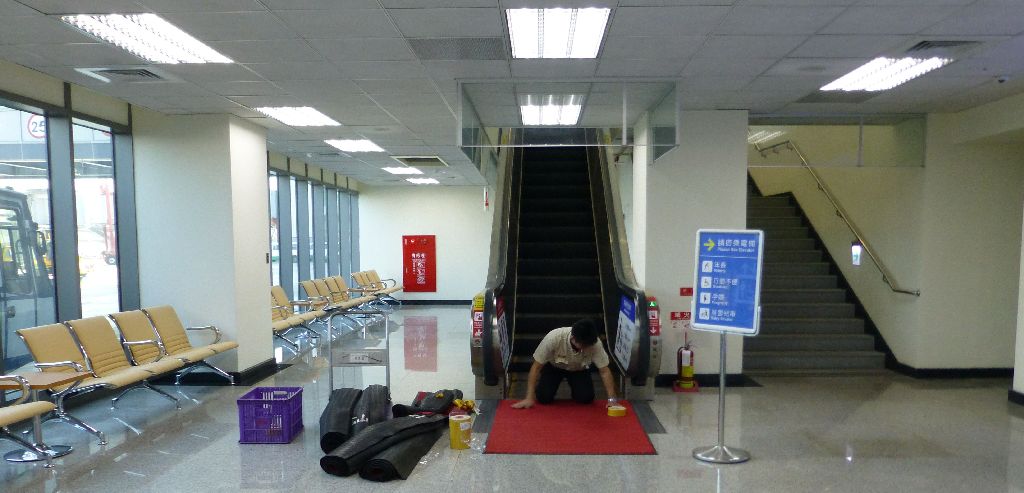
There is zero flight pier-side in the next future, and there is no soul there. This is an opportunity to look at what the staff sees when you board.

Actually, there is nothing very exciting. The only hint of the international area is the tail of a JAL 767.

There are actually few aircraft on the tarmac, apart from Win Air's Gulfstreams (a Taiwanese company providing corporate flights).

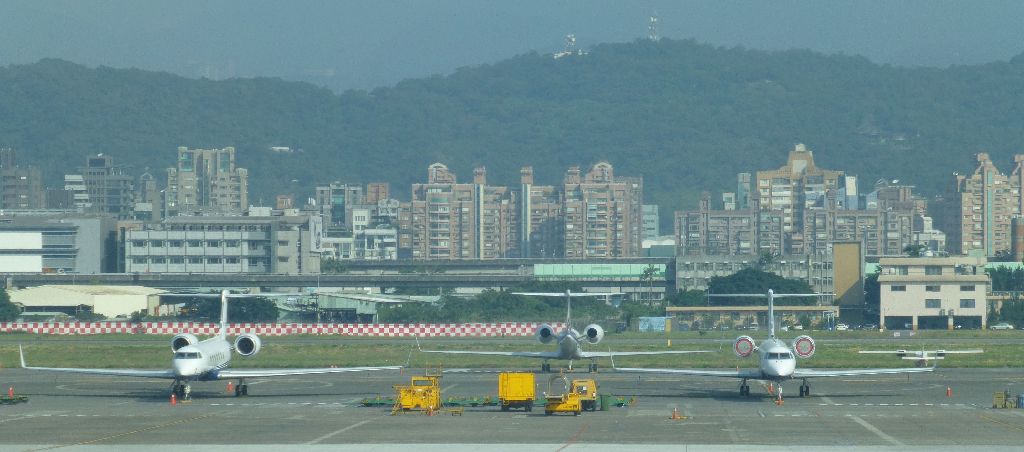
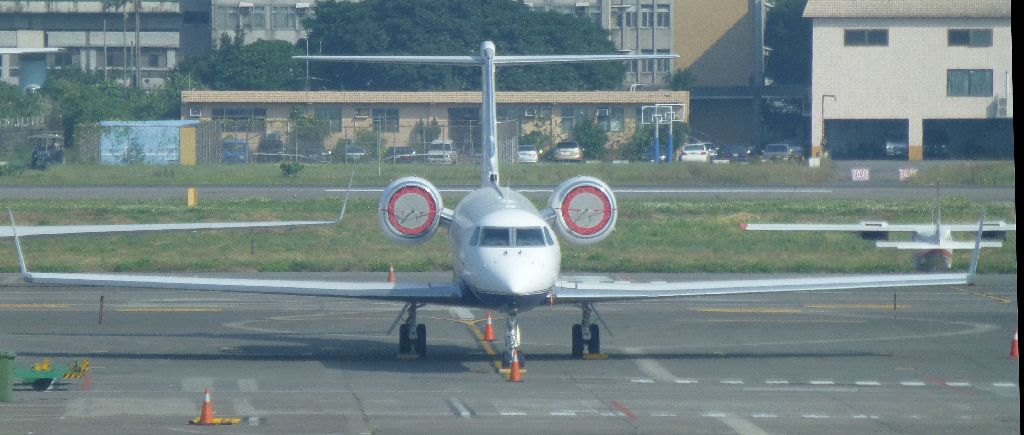
A government Beech 1900C taxies towards the runway
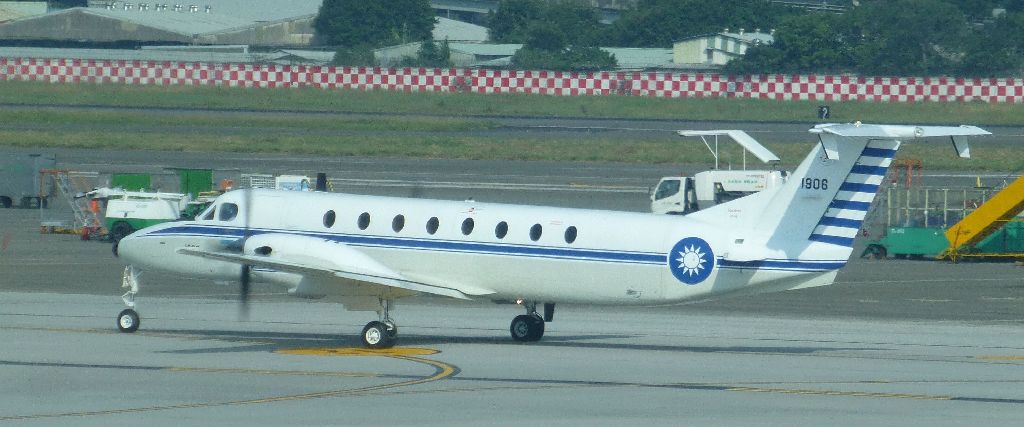
This Far Eastern Air Transport MD-82 without its reactors has been sitting here for two years and counting.
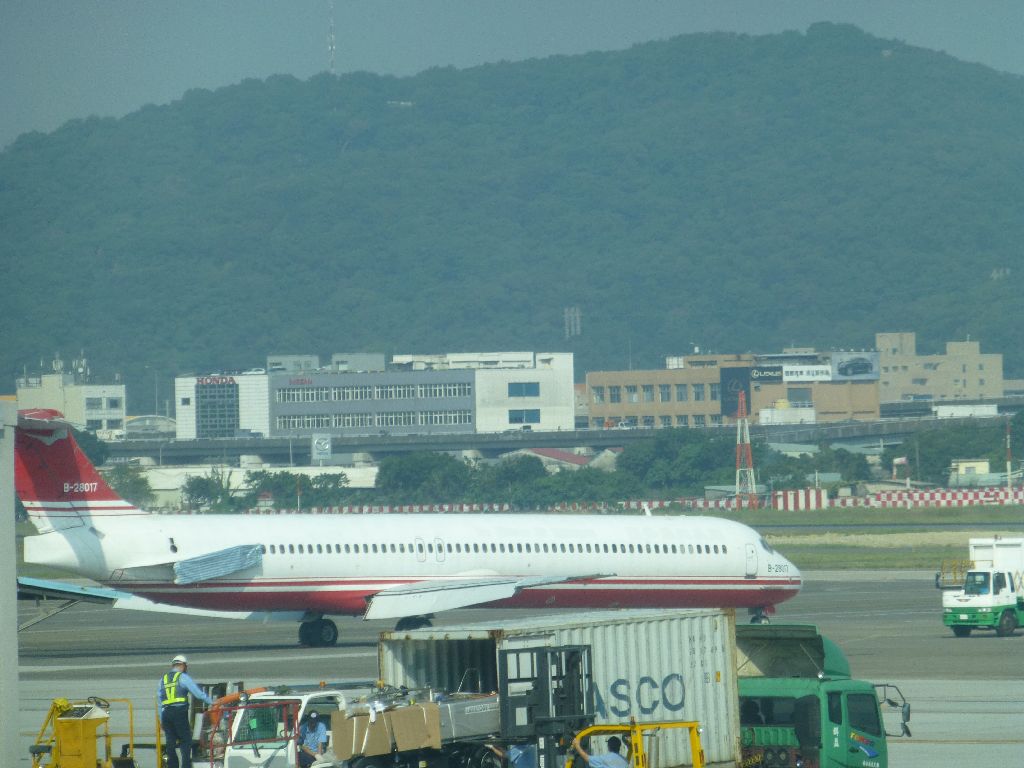
Back to the lower level once I had exhausted the plane spotting opportunities.

Transasia Airlines flight GE233 to Kinmen was announced late by an artificial voice on the PA
- in Mandarin / Japanese / Taiwanese
-and then twice in Mandarin / English / Taiwanese
-and then twice in Mandarin / hakka
They really tried to get the message across! (Taiwanese is derived from Minnan, which together with Hakka are the two Chinese languages used in the Mainland province of Fujian which faces Taiwan).
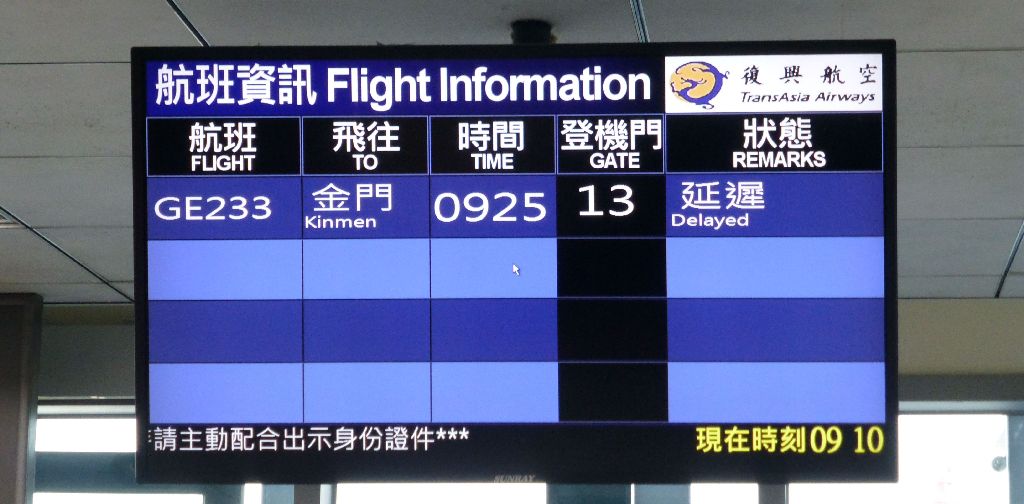
No problem so far with Uni-Air, but better say it quickly,

… because soon afterwards, our flight was announced late, live in Mandarin and Taiwanese (twice) and then by a synthetic voice in Mandarin / English / Taiwanese.
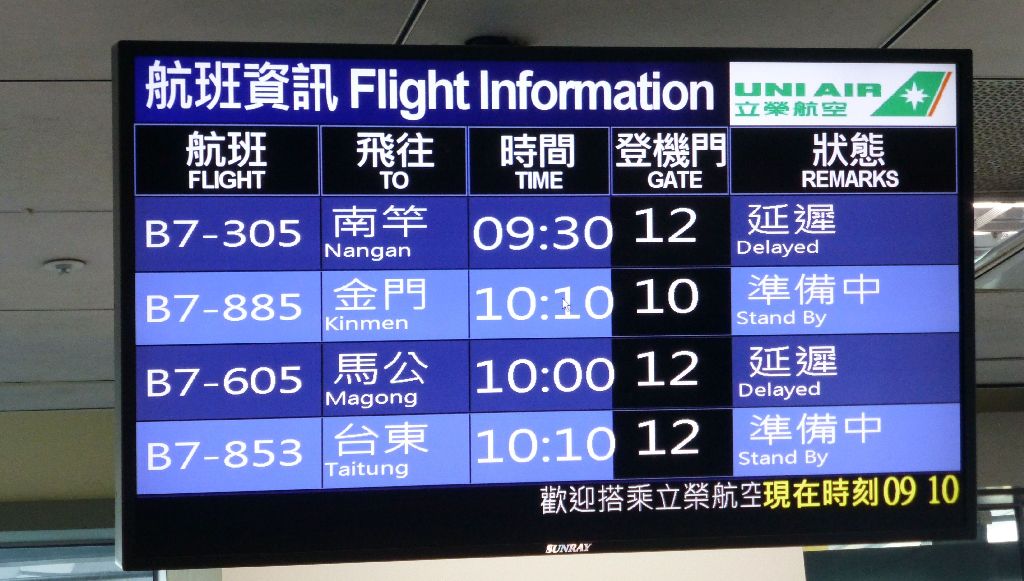
But English speakers can be reassured: we then had a synthetic voice in Mandarin / English / Taiwanese for the added in information… that the updated time of departure would be announced later.
The flight was indeed eventually announced delayed to 9:40.
At Uni-Air's counter, the flight information was updated by an employee who smiled nearly as much as her cardboard cutout colleagues.
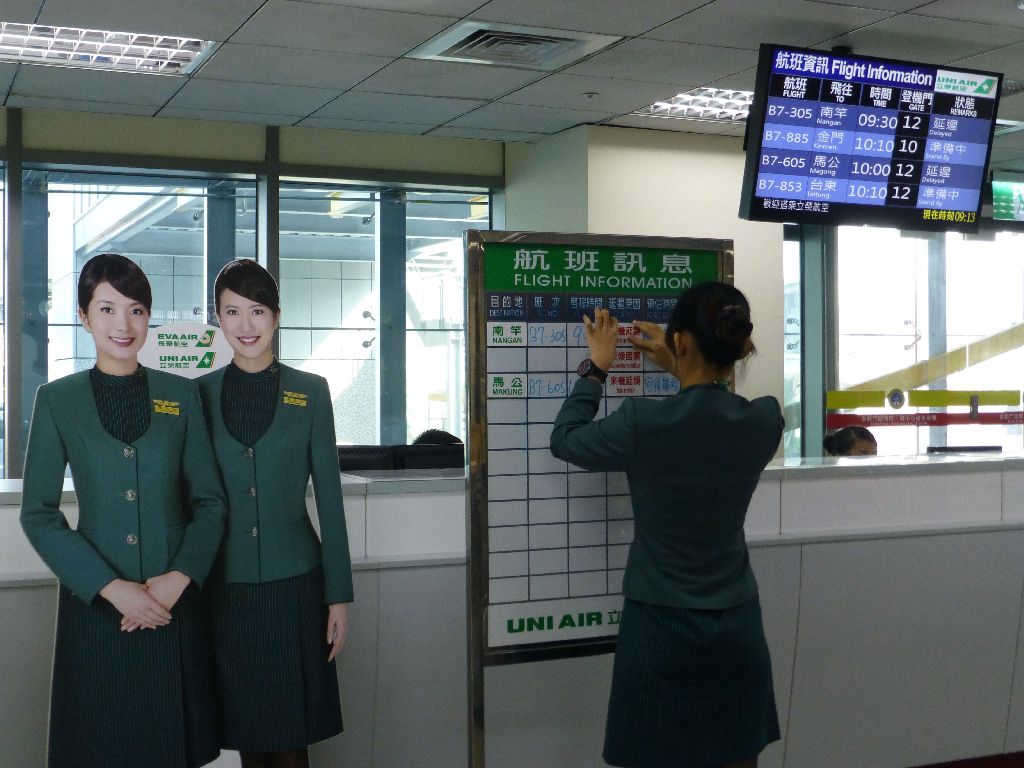
We had a bright blue sky in Taipei, but two hundred kilometers away, it was going to be another story

The flight is still supposed to be on time here
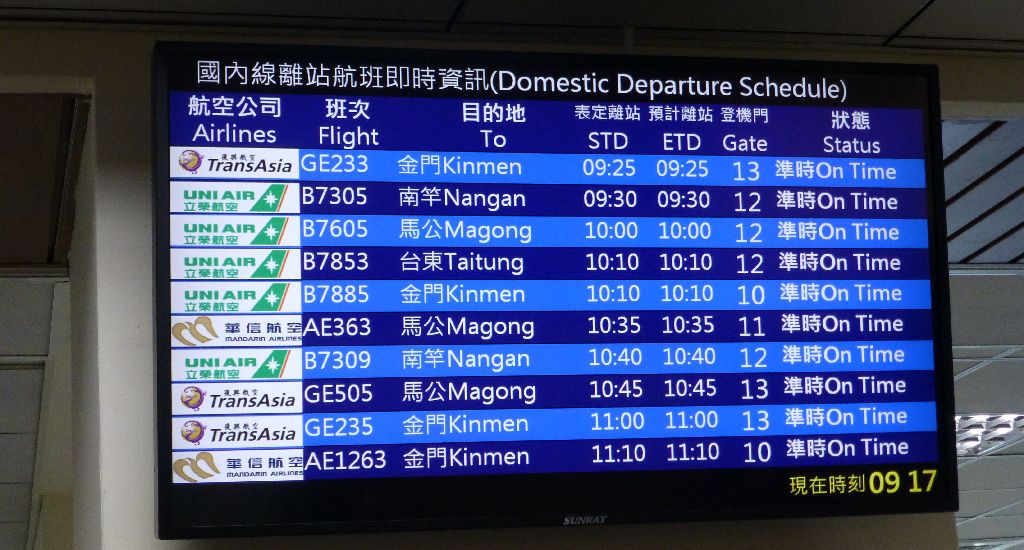
… but not for long
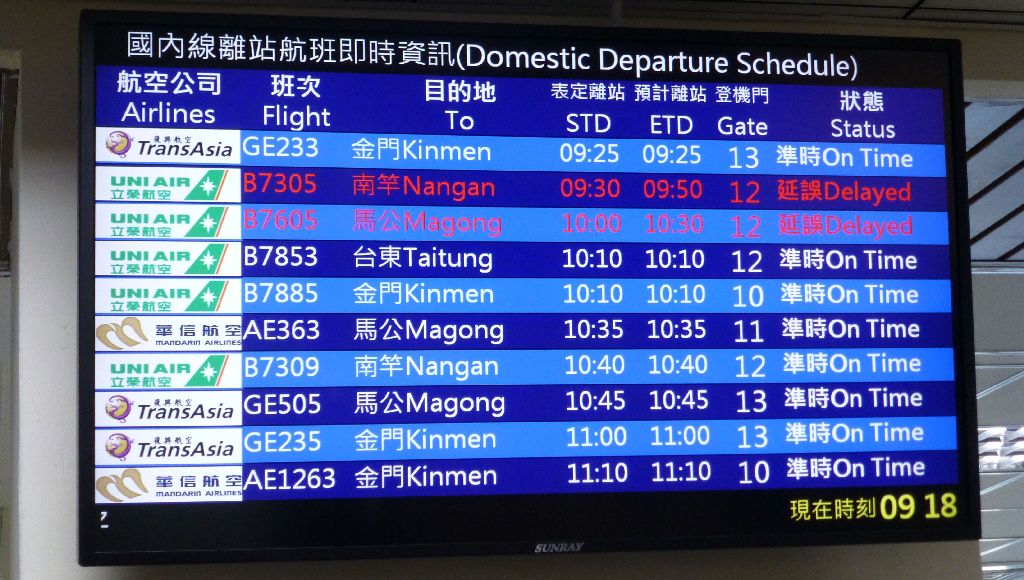
The white board is also updated
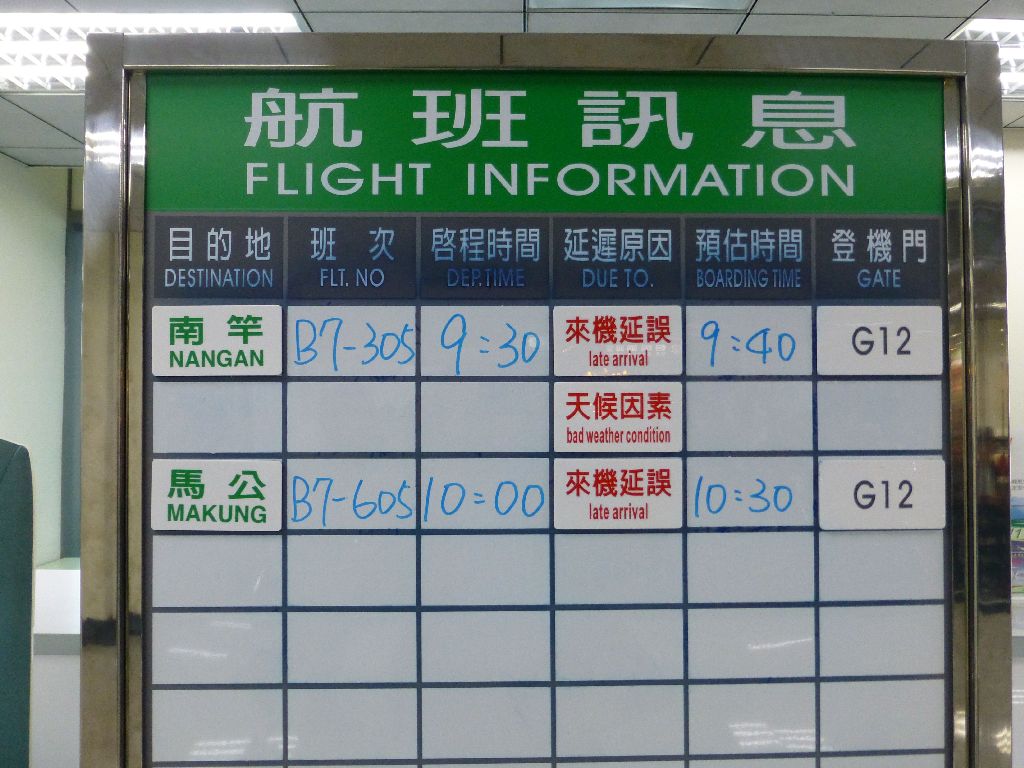
So we boarded ten minutes late…
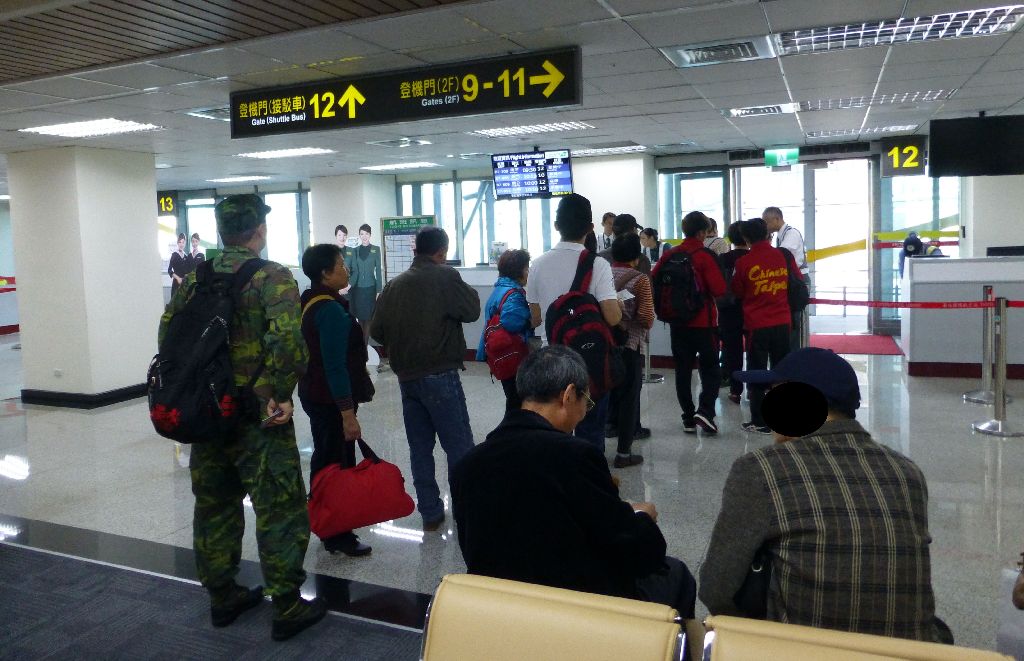
… in this passenger bus with doors on all sides.
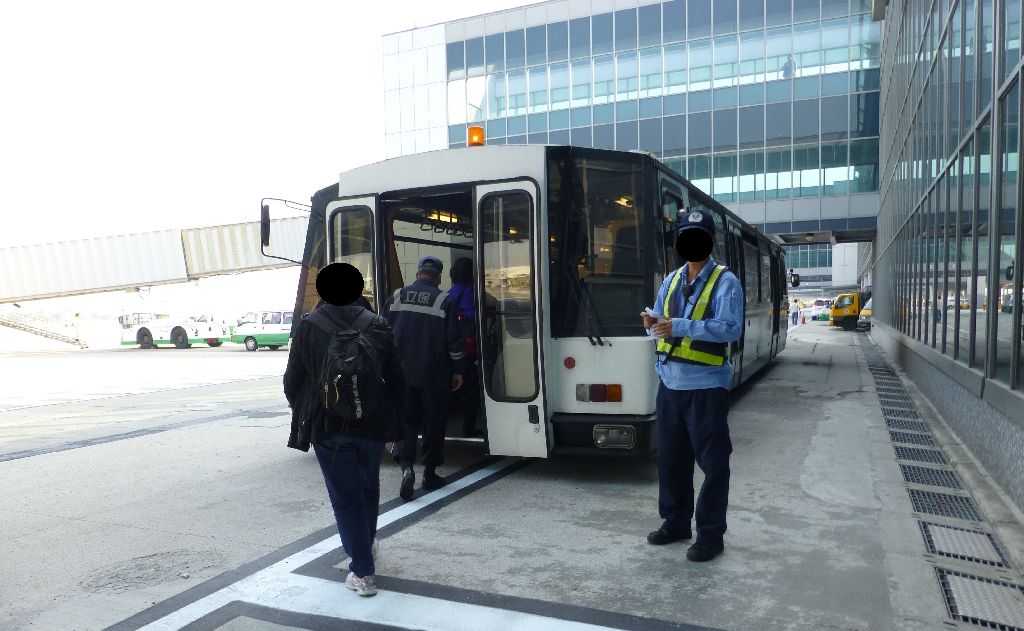
A JAL 767 taxies, unfortunately masked by miscellaneous equipment.

.. followed by a Transasia Airlines ATR-72
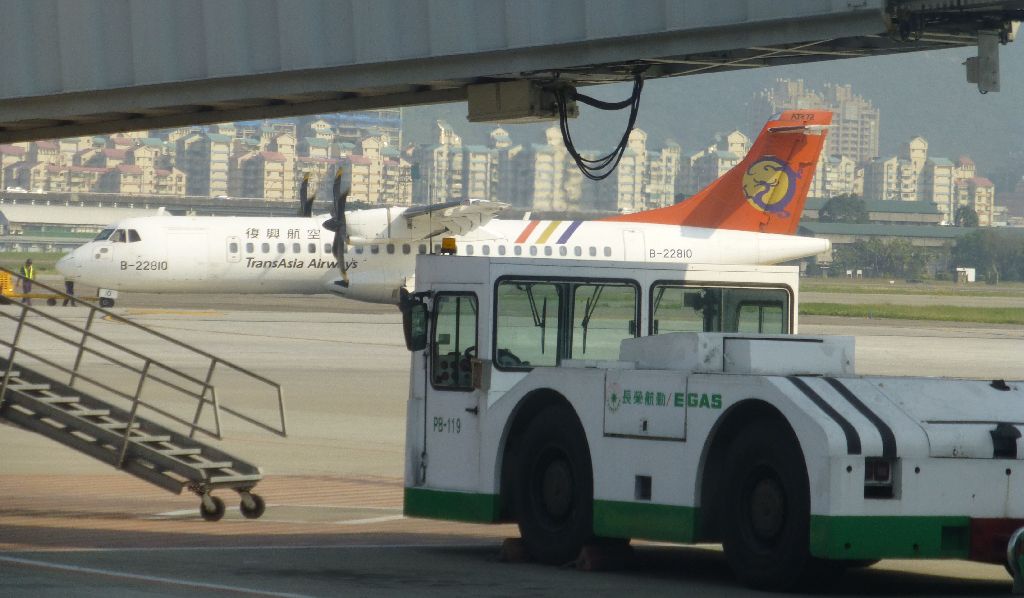
From the bus, a Uni-Air MD-90 Uni-Air in the old orange livery
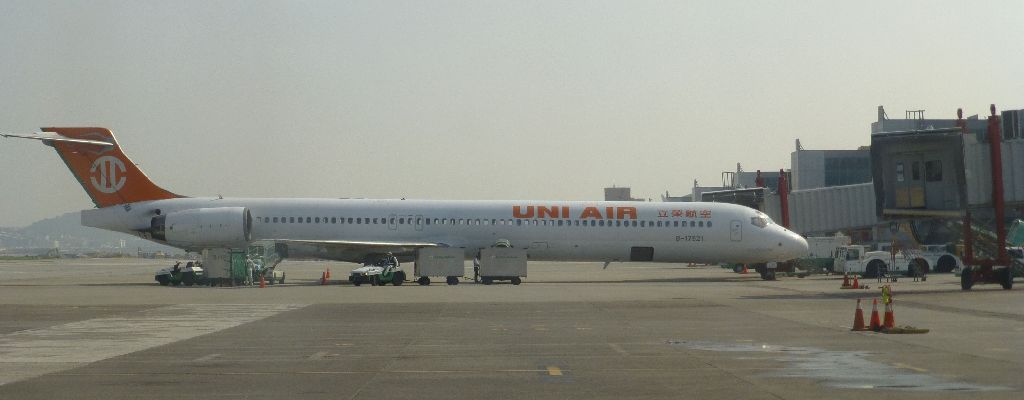
A bumbling bee departing Transasia Airlines ATR-72
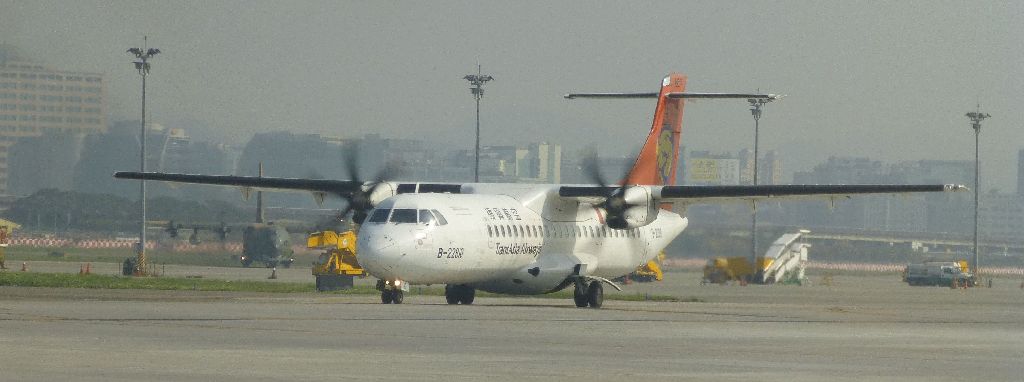
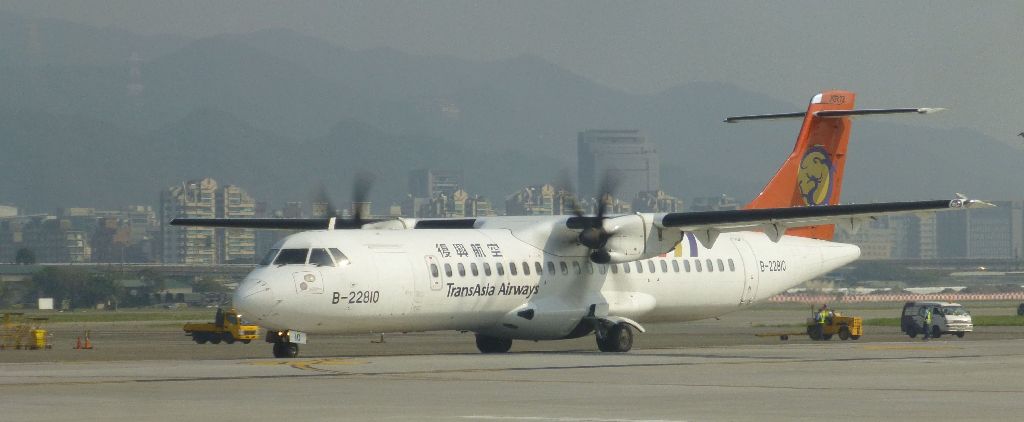
We reached this Dash-8 which was probably not quite ready, because we waited a long time with the bus doors closed. They were possibly trying to recover from a late arrival.
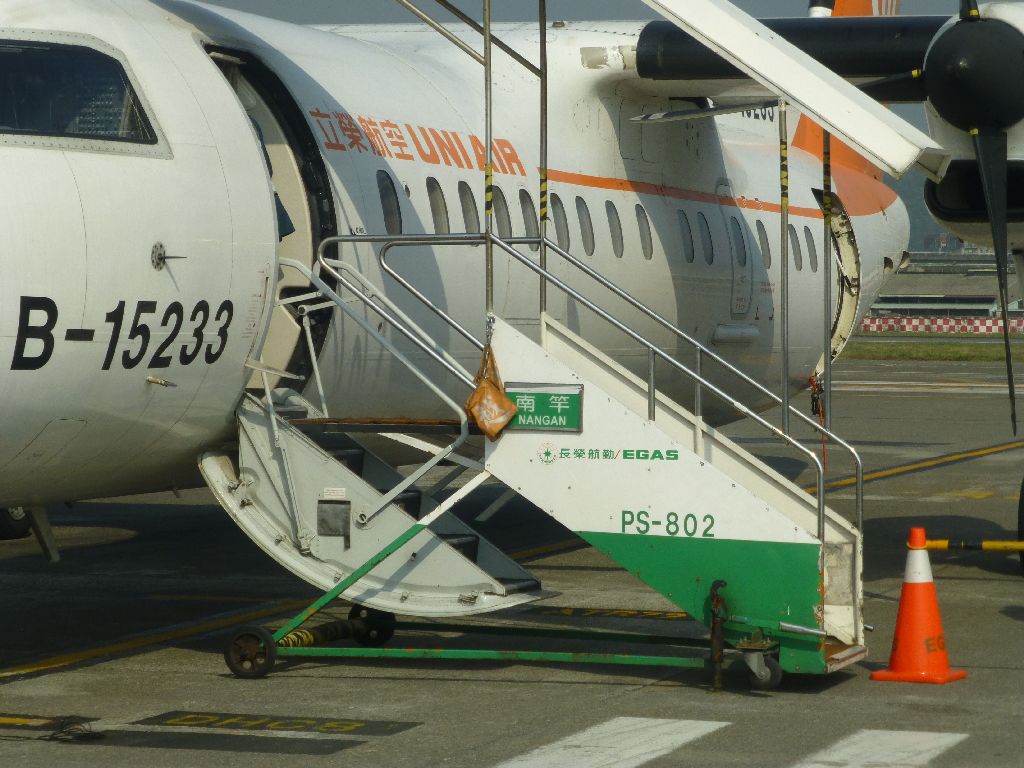
No doubt about the destination: a sign confirmed that our destination was indeed Nangan.

The small wait in the passenger bus provided me a photo opportunity of that passing C-130
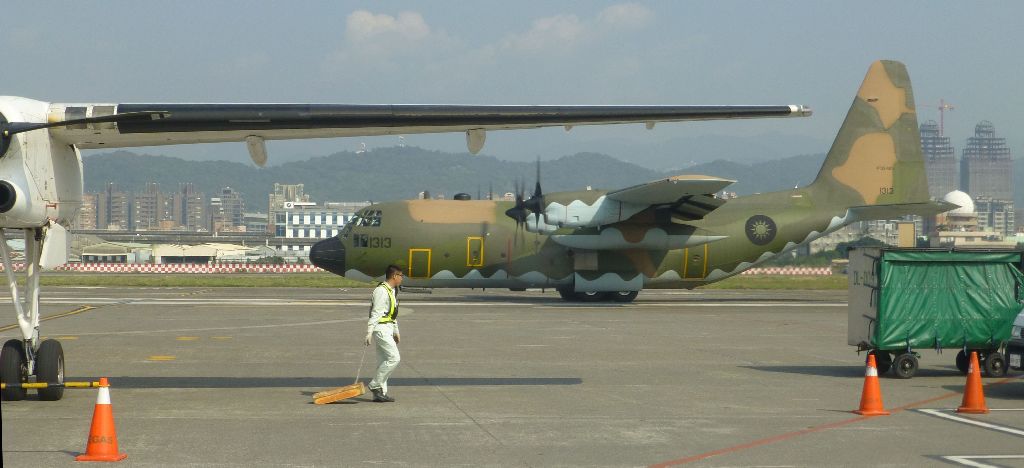
And the takeoff of JAL's 767 in the background
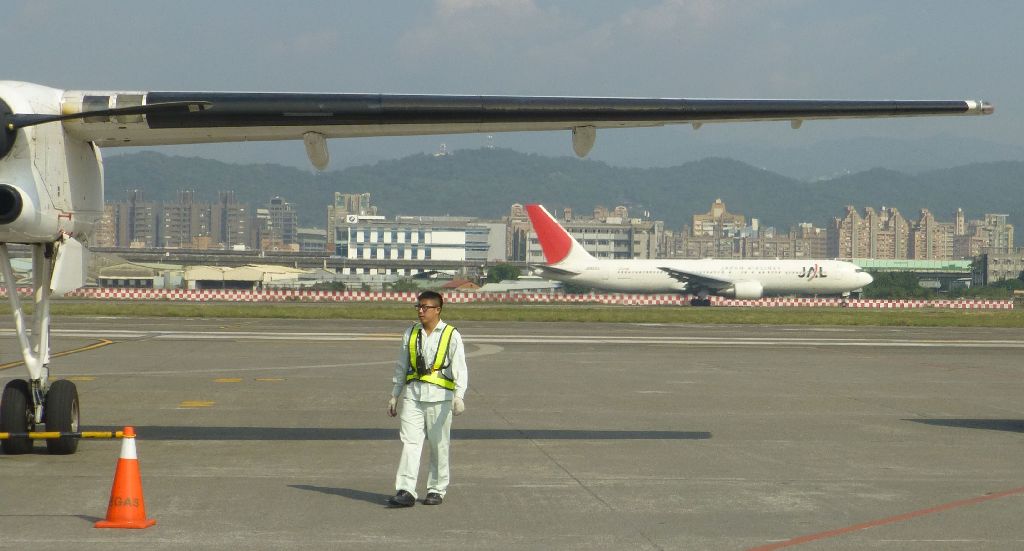
The captain on our flight
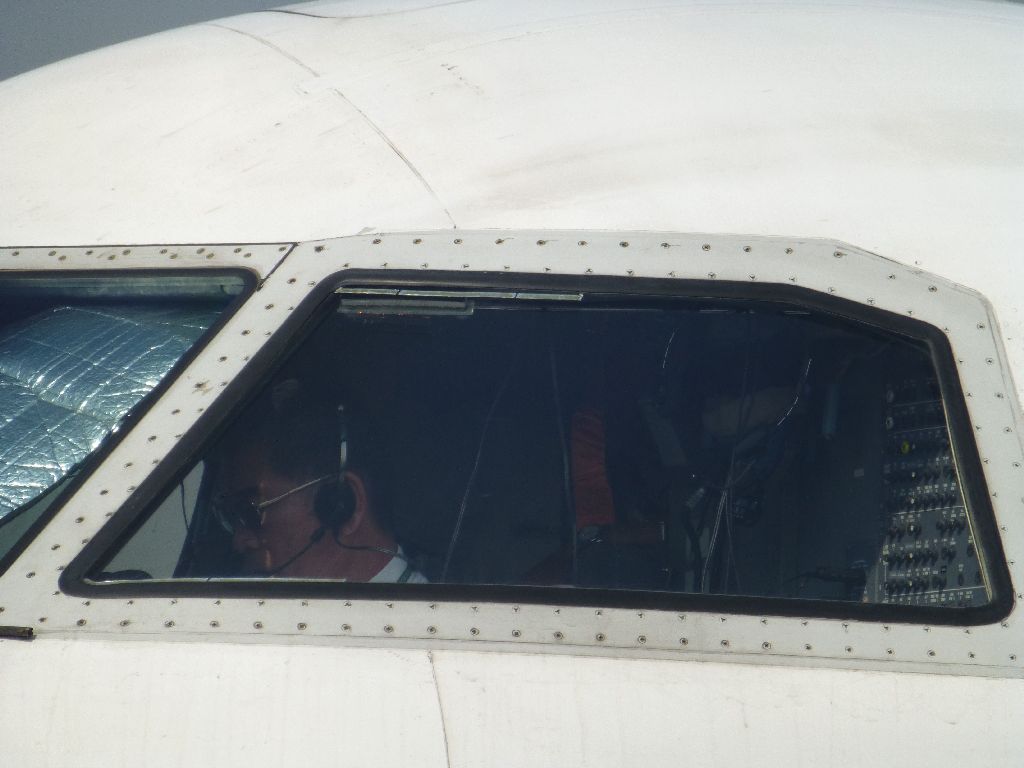
Boarding
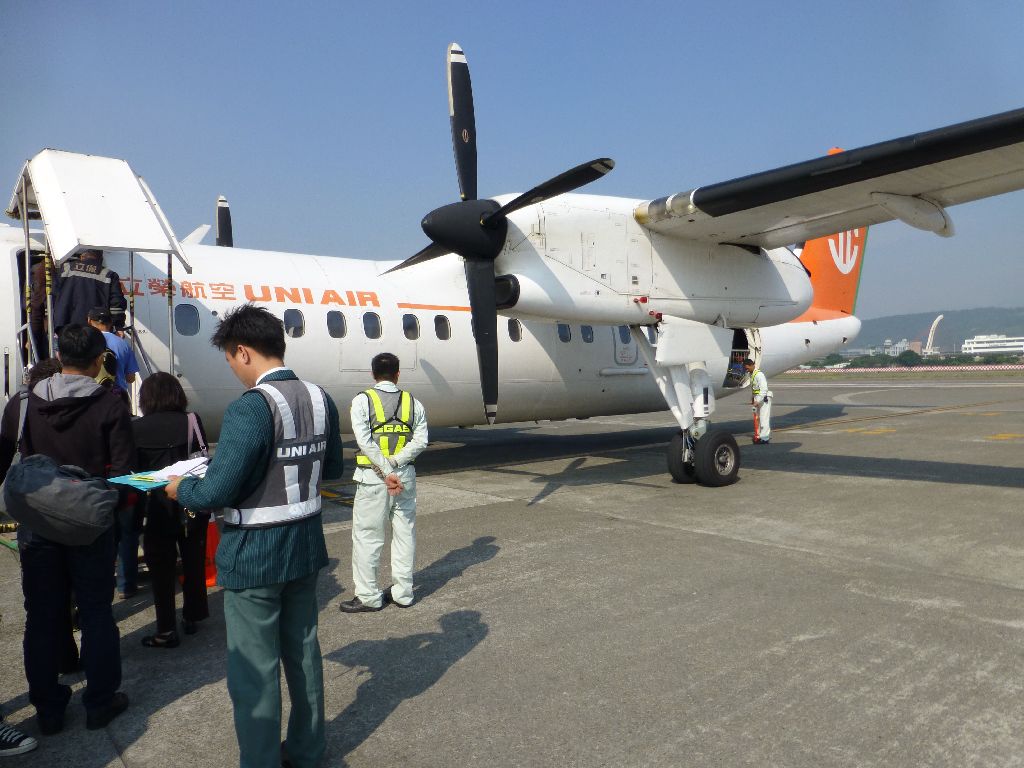
Luggage hold closing

A turboprop engine is very silent
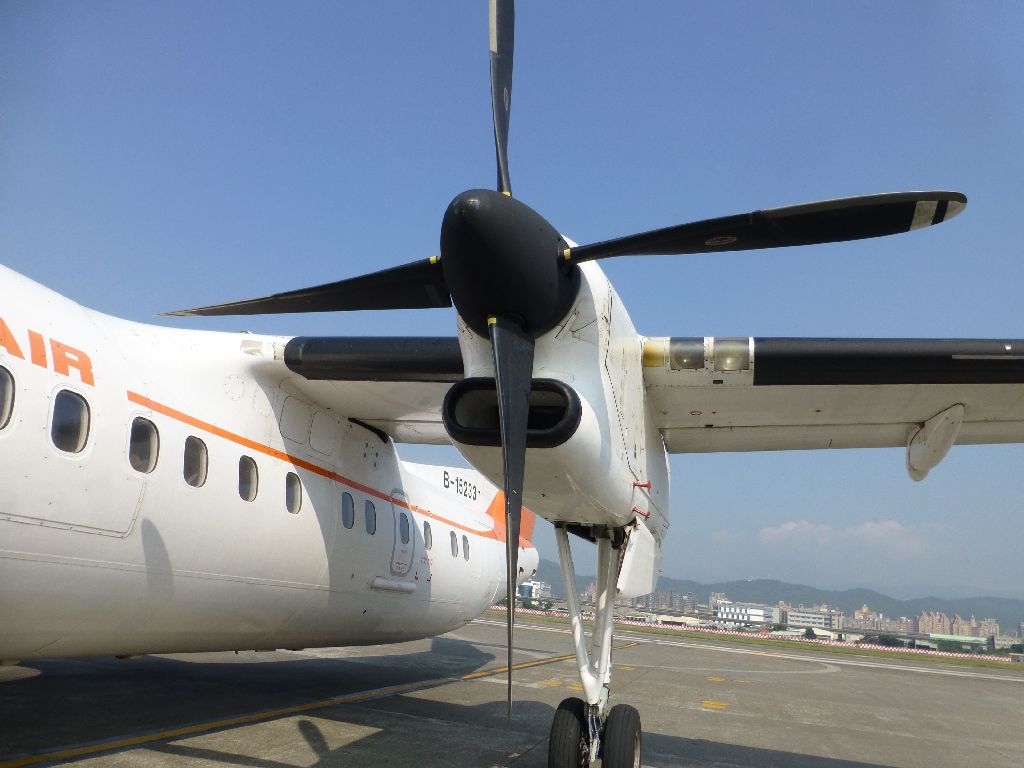
or rather this is what Bombardier claims. I remain unconvinced after accumulating a number of flights in Uni Air's Dash-8 and Transasia's French-Italian made ATR72.
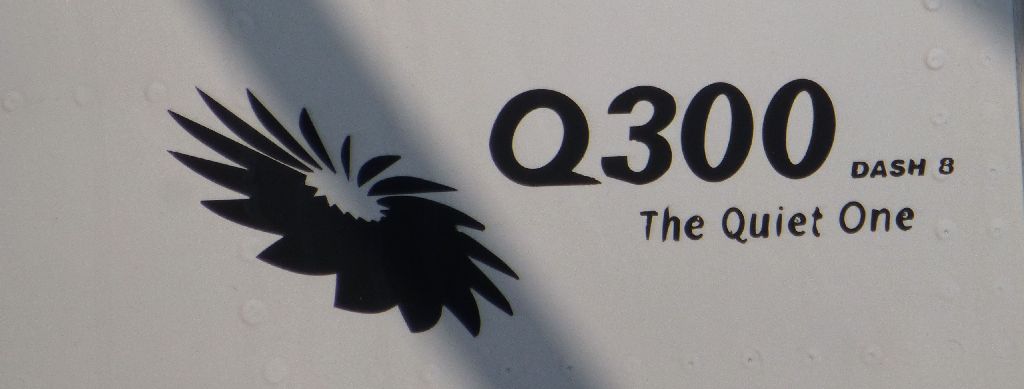
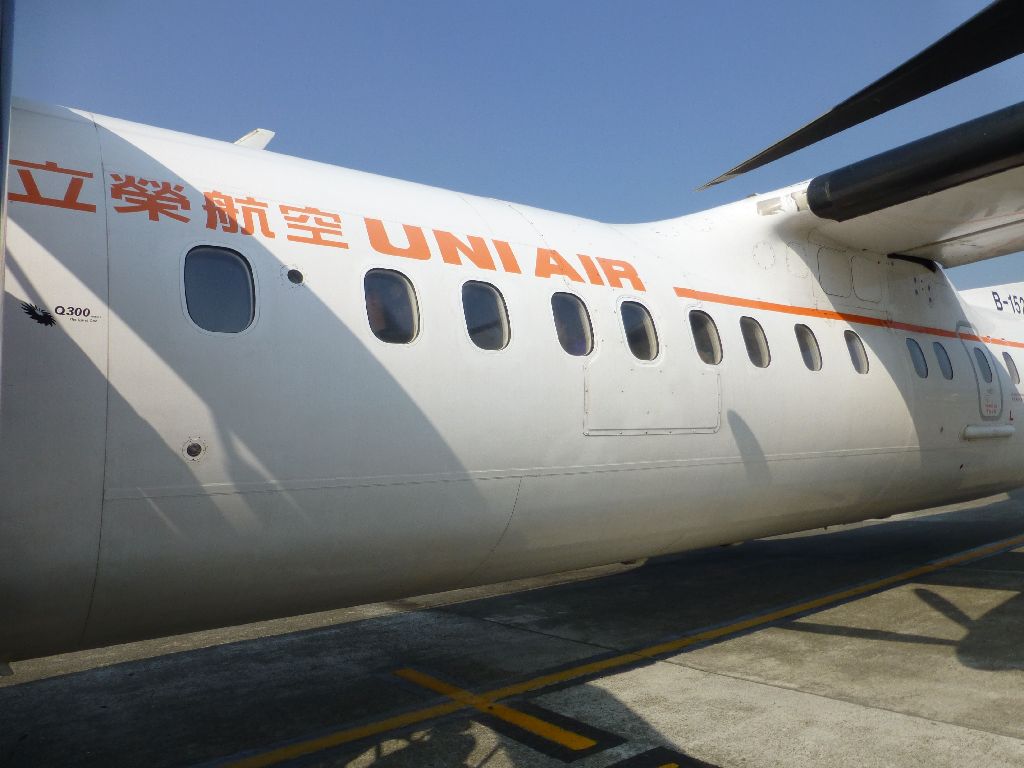
One of my favorite views of a Dash-8
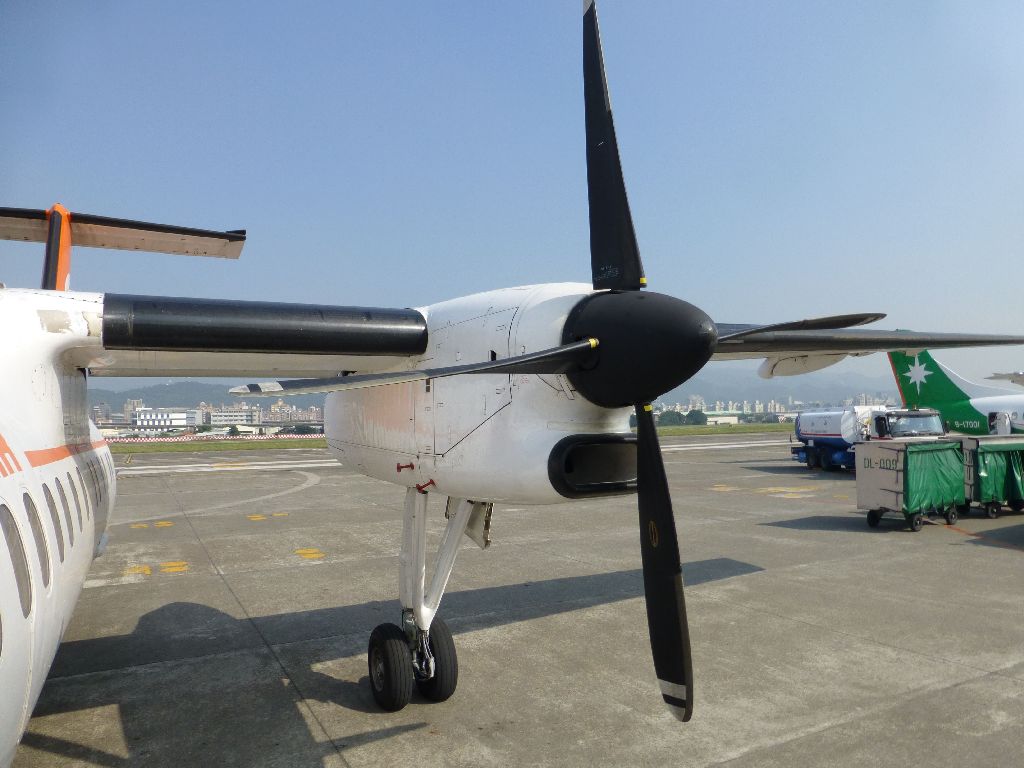
I did not check if the front wheel was on the mark, but it definitely was not far from it.

The window pane was so badly scratched that I suspected that it had never been changed since the Dash-8 registered B-15233 was built seventeen years ago.
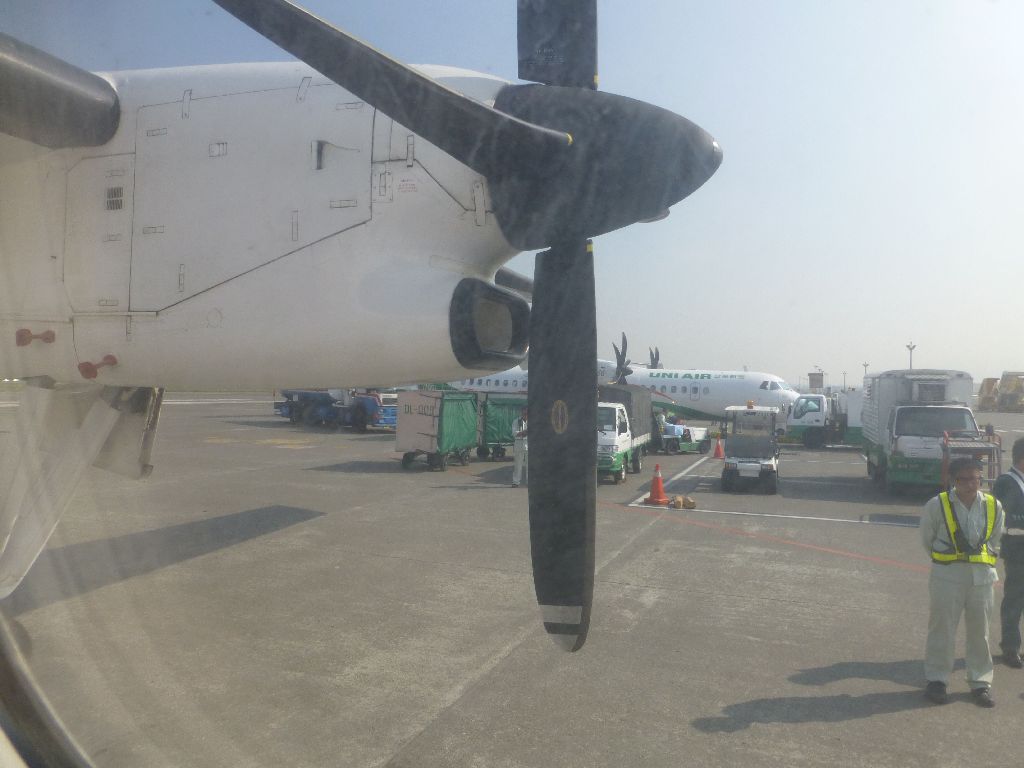
The safety instruction sheet was badly warped and discolored and showed her age.

The aircraft was full, even the front right seats facing backwards were occupied.
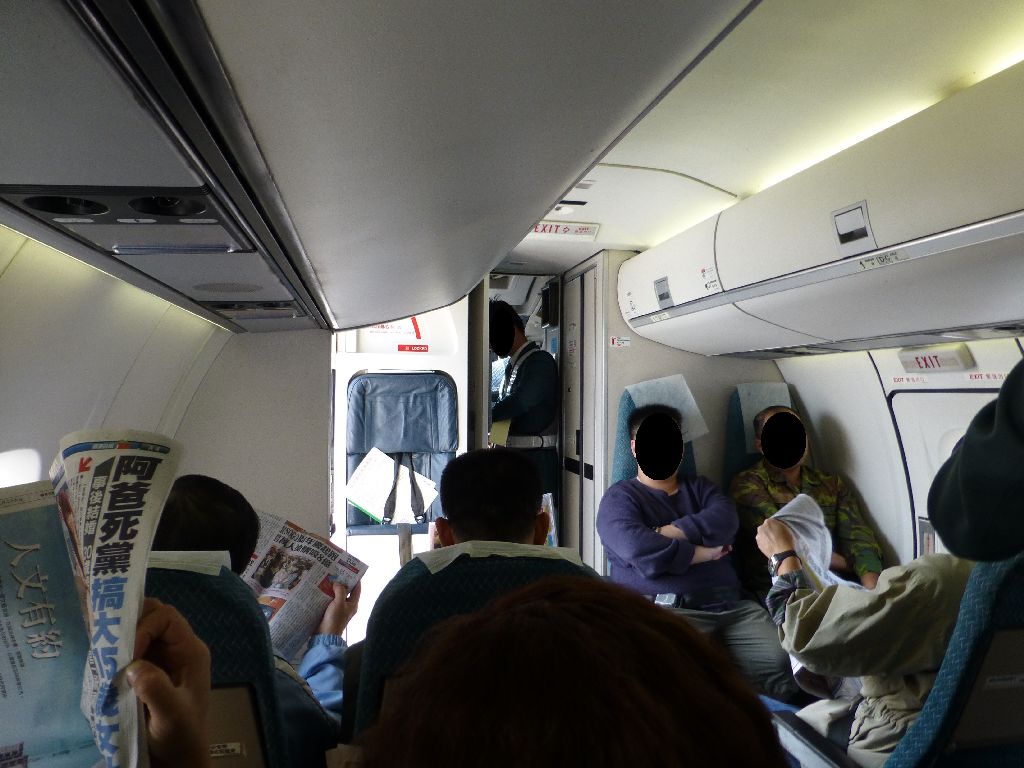
The flight attendant made the usual speech to the occupants of these seats next to the emergency exit (in case of emergency, please follow the flight attendants' instructions, and if you think that you may not understand them, say it now so that we can exchange with somebody else). Foreigners are never assigned these seats, since they cannot understand Mandarin, which is good news, because these seats are in full view of the flight attendant on her jumpseat on the left, which makes it impossible to take pictures during take-off and landing.
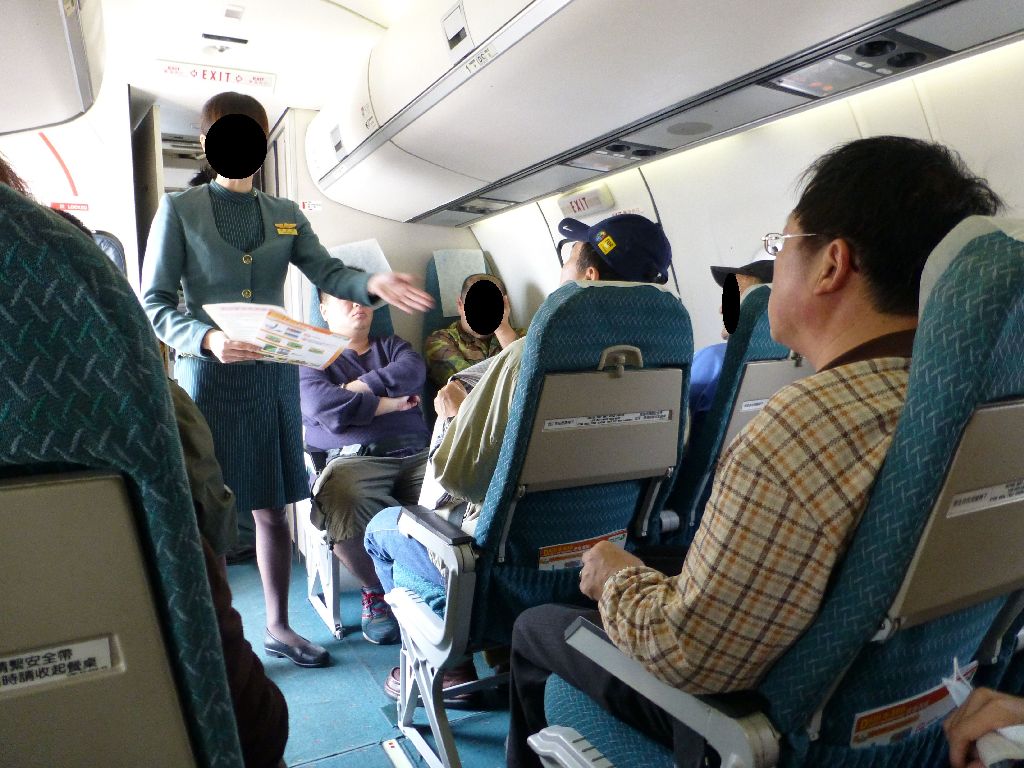
View of the rear of the cabin

An explanation for this picture: the passenger on the right had some painfully stuck debris stuck under a nail and tried in vain to remove it (it had started in the boarding room). A flight attendant brought her a tiny sewing kit (the kind that you find in hotel rooms) to try and use the needle. One bonus point for the crew.

The seat pitch, with shoes which had so far spent more time in Japan than in Taiwan, because I had bought them just before our flight to KIX.
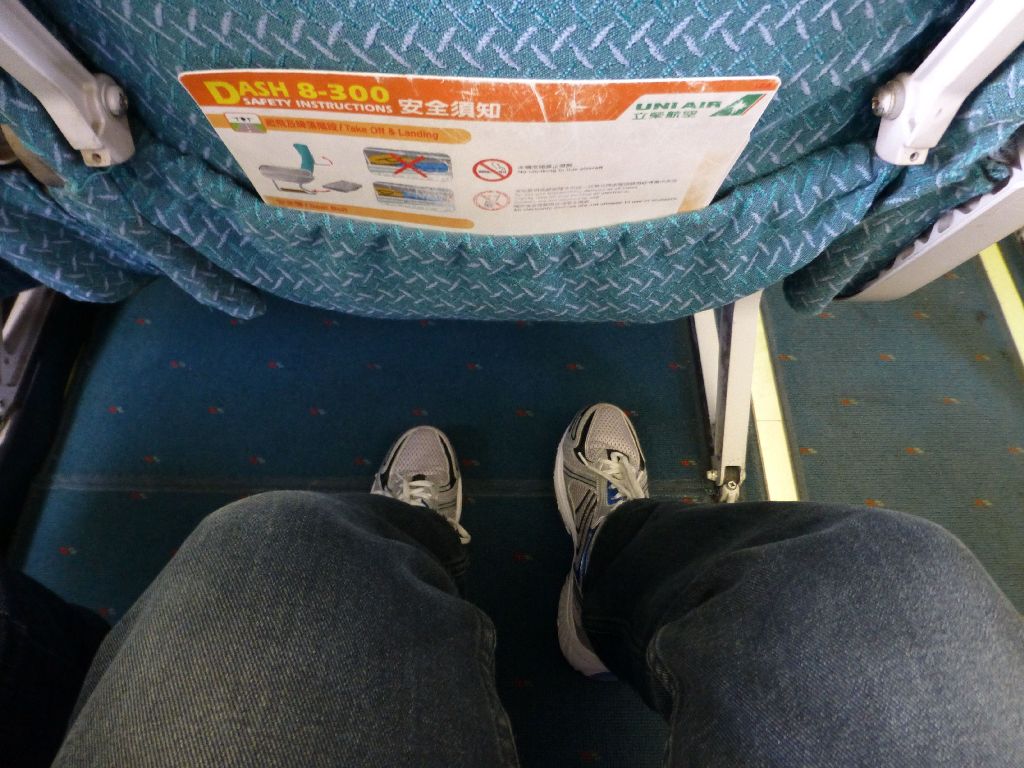
Take off in a bright blue sky
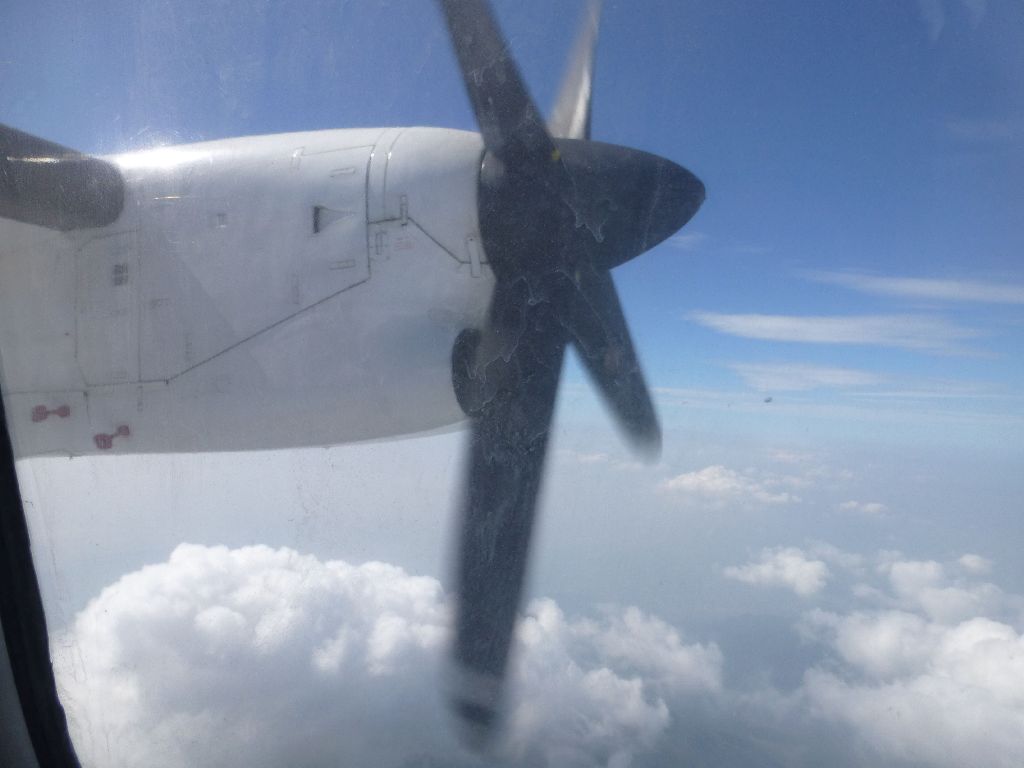
A flight attendant distributes newspapers, and takes in a separate overhead bin two copies of an English language newspaper for us. It is a Taiwanese newspaper, since the official name of Taiwan is Republic of China.
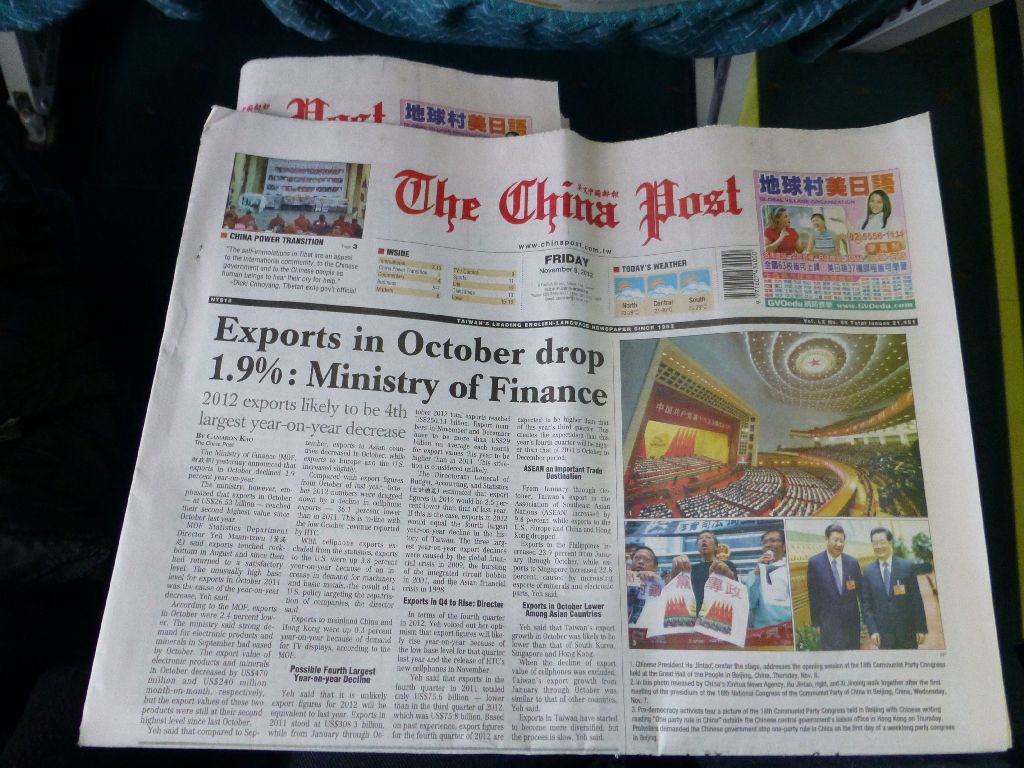
Drinks service begins
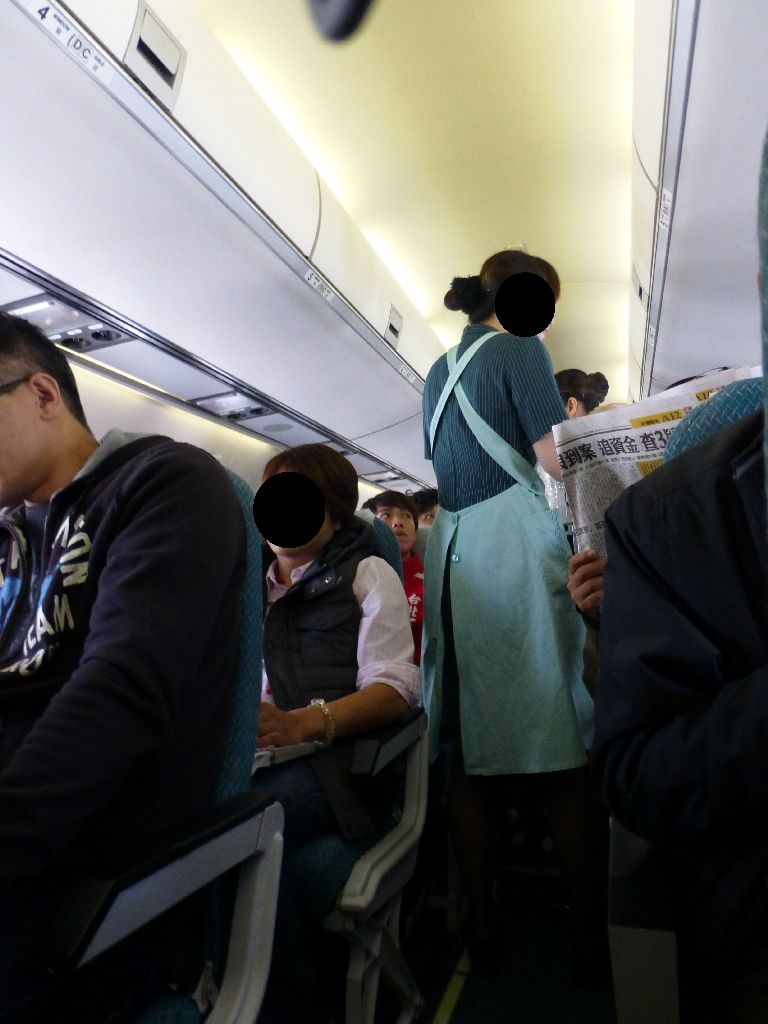
Because of an unusual misunderstanding, I received both a paper cup of bad, very bad tea, and a paper cup of coffee made acceptable by the milk and sugar which was already there.
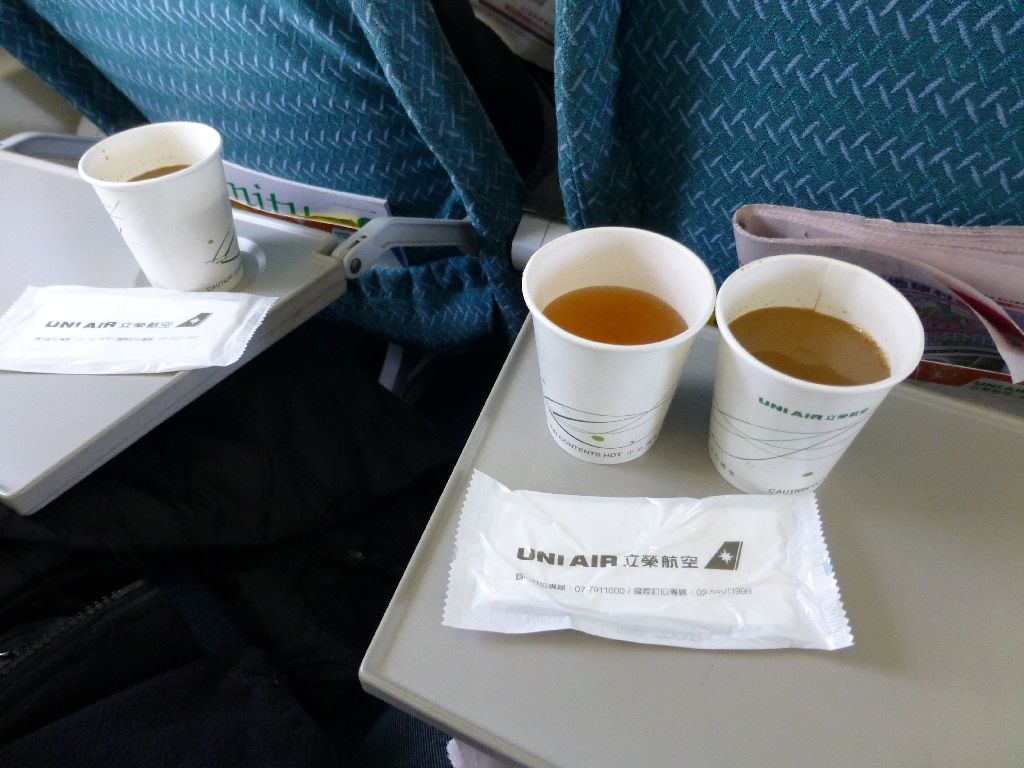
Rather than keeping watch on each other, the Chinese and Taiwanese Coast Guard patrol boats should keep watch on the cargo ships dump oily ballast water in the Straits of Taiwan (the diagonal line in the center).

And highlighted here by image processing
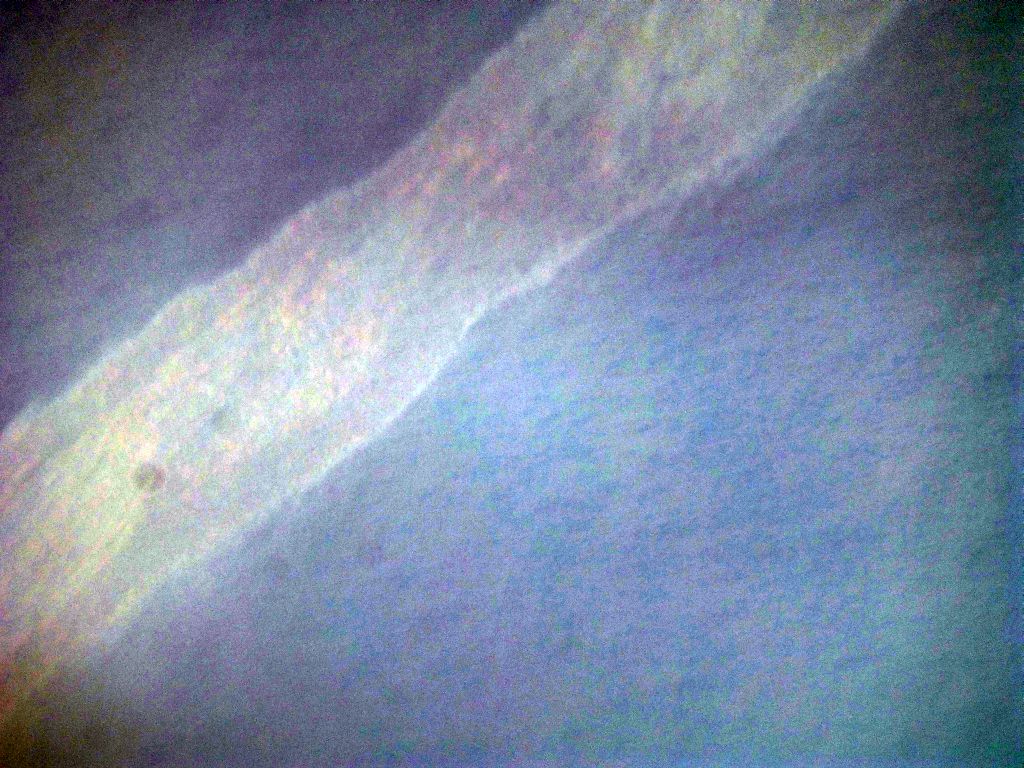
Not only the water, but also the air was getting less and clear.
The aircraft descended towards Nangan in deepening clouds, and suddenly, before the landing gear was down, the pilot pulled up with full throttle. The plane vibrated intensely (the Quiet One?) and regained altitude. A few minutes later, the pilot announced in Mandarin:
-The weather is too bad and the ceiling is too low in Nangan; we'll attempt landing in Beigan.
After I had translated to her, my wife started creating Plan B and Plan C:
- Beigan is next door, the weather will be the same. If we can't land in Beigan either, where do we go? Do they have enough fuel to make it back to Taipei?
- There is another airport which is much closer than Taipei, and just as well equipped for bad weather landings, in Fuzhou (FOC).
- But that's on the Mainland! We don't have a Chinese visa! [and I didn't even have my passport, only my Taiwanese resident ID]
She was not the only worried woman on board, because the two flight attendants came up with an opened English phrase book. I told them immediately in Mandarin:
- I know, we are going to Beigan, aren't we?
It did not take any Chinese language skill to my wife to read the immense relief on the face of the flight attendants who had obviously feared the worse when came the time to explain the situation to foreigners who cannot handle an emergency exit since they cannot possibly understand Mandarin, but would nevertheless land in emergency in the wrong airport. Their hesitant reading of the standard announcement before take-off was enough proof that they definitely could not communicate in English.
Beigan Island is indeed only a few kilometers away, and its runway is coincidentally aligned with that of Nangan, but it took at least ten additional minutes in deep fog until we got under the cloud ceiling, just as the landing gear dropped with its characteristic clonking sound.
We could barely distinguish Beigan: it was not a badly scratched window, but really bad weather.
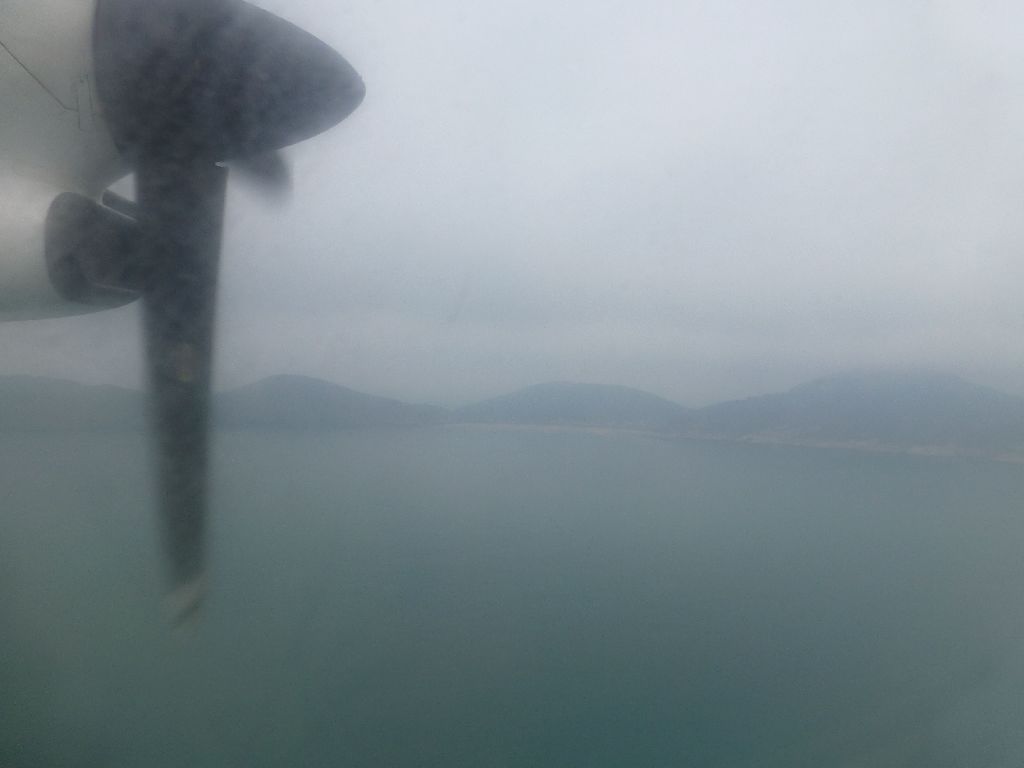

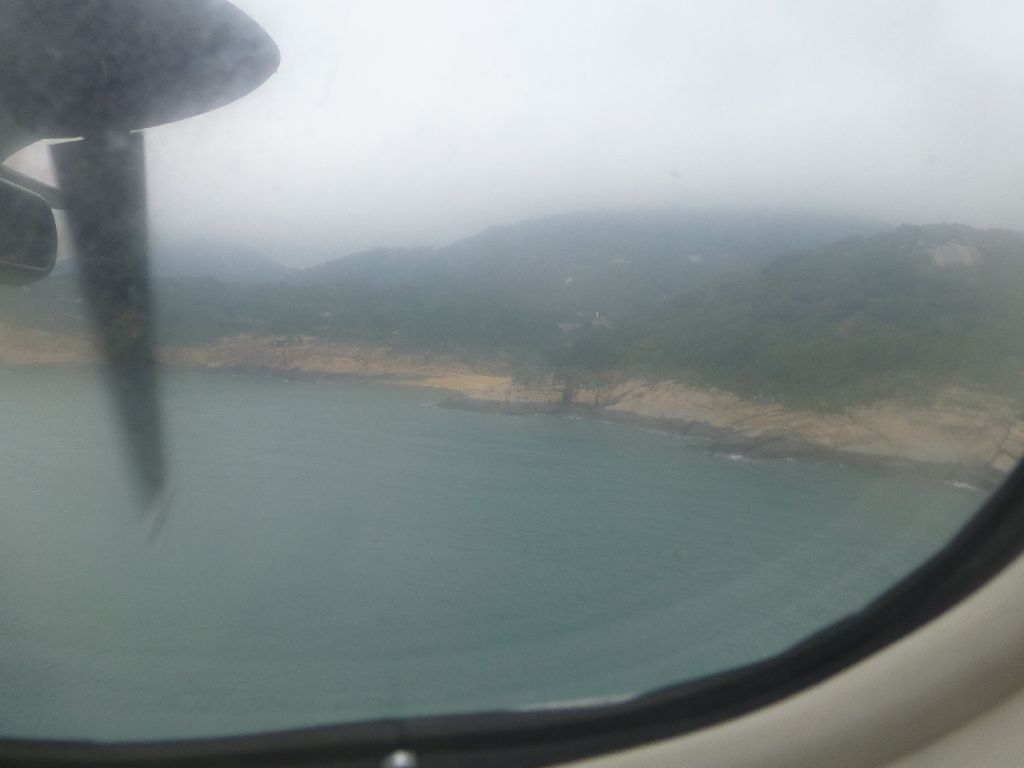
The major difference between Nangan and Beigan was that Nangan's runway has been cut away from a hill side 232 feet above sea level, whereas that of Beigan is a few feet above sea level, and actually partly on a jetty. Some 220 feet elevation difference was what the Dash-8 needed to squeeze between the actual cloud ceiling and the minimum required to land.

Furthermore, Nangan's runway is of course long enough for a fully loaded Dash-8 on a zero wind day, but it ends with a sheer cliff on both ends. Landing on Nangan is akin to landing on an aircraft carrier, and a failed carrier landing is a very messy business. Better give up when you feel that you may not make it, and Nangan bound Flight B7-305 landed in Beigan.
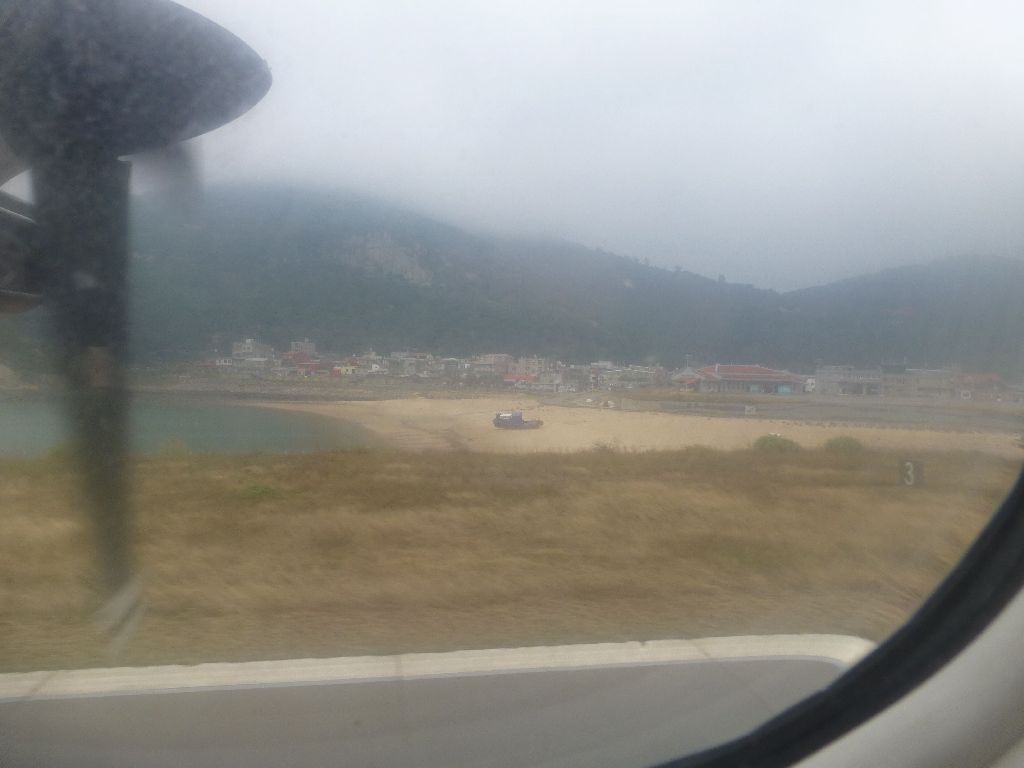
Arrival at MFK of LZN bound flight B7305. The flight attendant struggles to read We hope that you have enjoyed your flight and hope to see you again. Uni-Air takes no risk in hoping seeing again passengers landing in MFK or LZN, since they have a monopoly on flights to/from these islands, but yes, I did enjoy this flight, probably more than she thought.
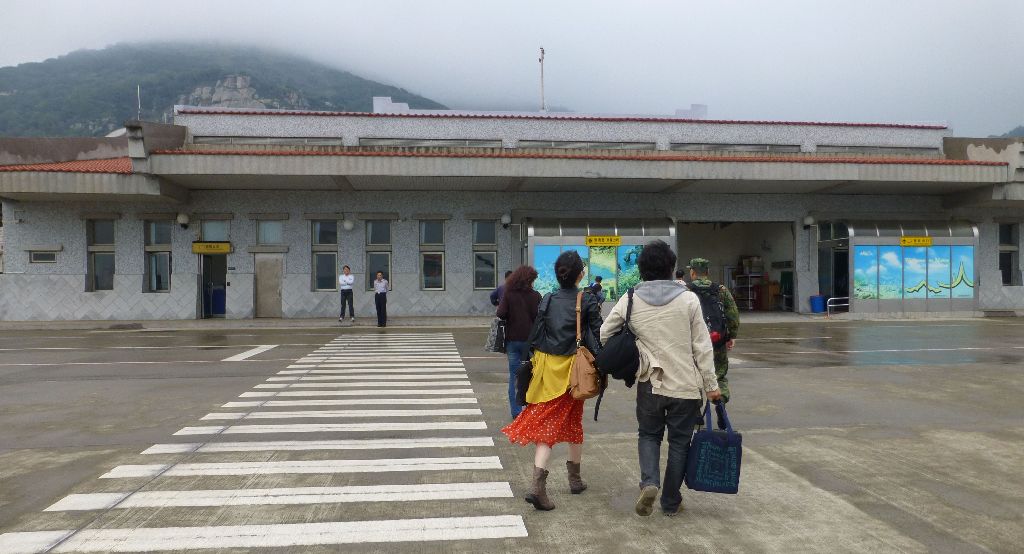

In the tiny luggage delivery room, the map said it all: we had landed in Beigan's airport at the north-east of the island, and the harbor is at the south-west tip, five to six kilometers away.
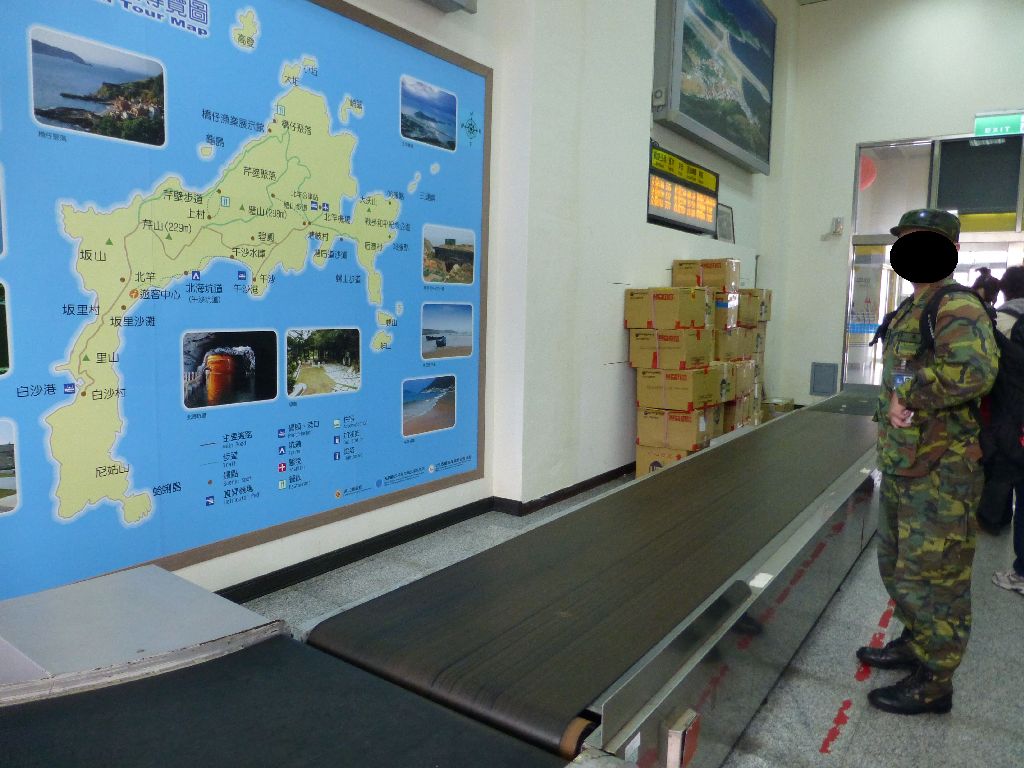
The list of that day's arrivals is not up to date
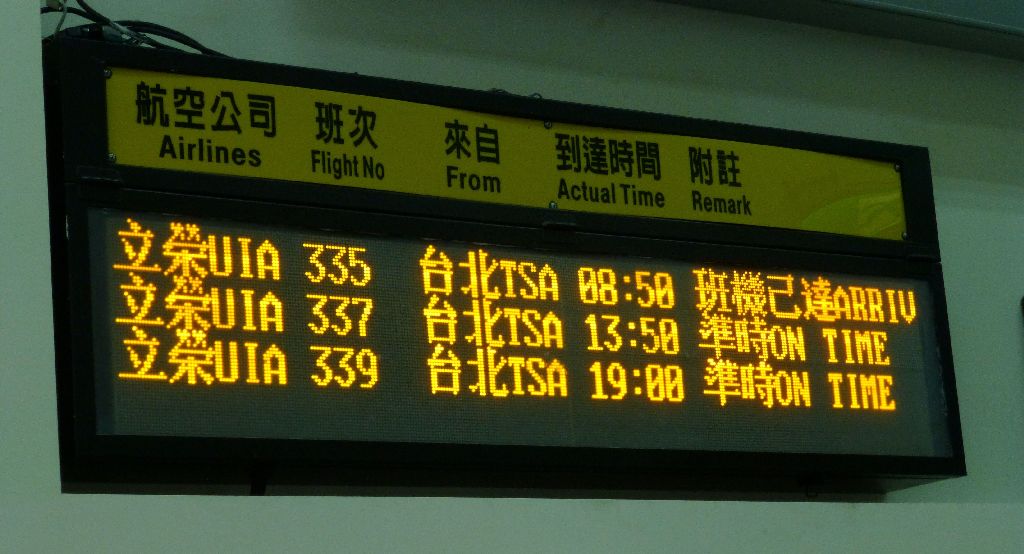
The pick-up truck which brings the luggage
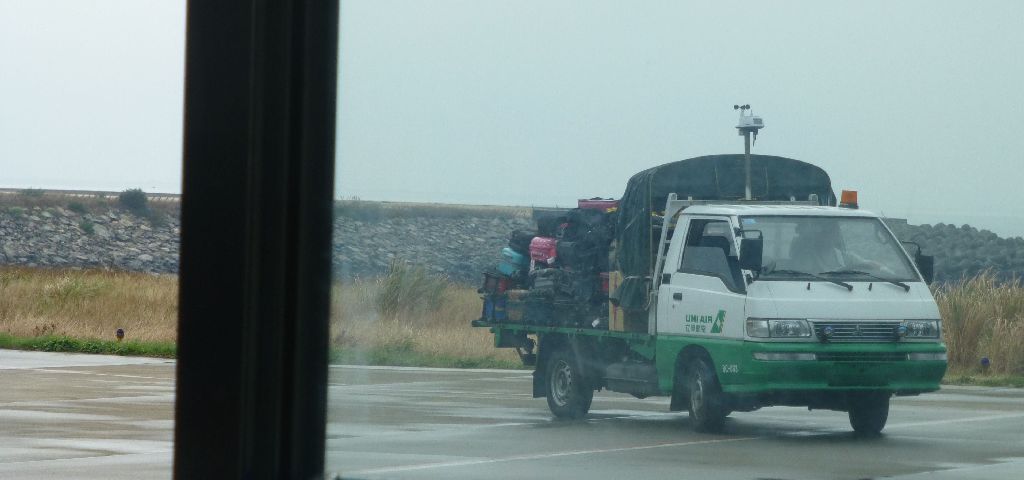
At the exit of the terminal, there was no time to waste: a Dash-8 full load of Nangan bound passengers just landed in Beigan, and there are five taxis. I immediately headed towards one to go to the harbor. The female driver civilly answered that she would take an extra passenger and I civilly accepted that they be two.

So, direction Baisha harbor…
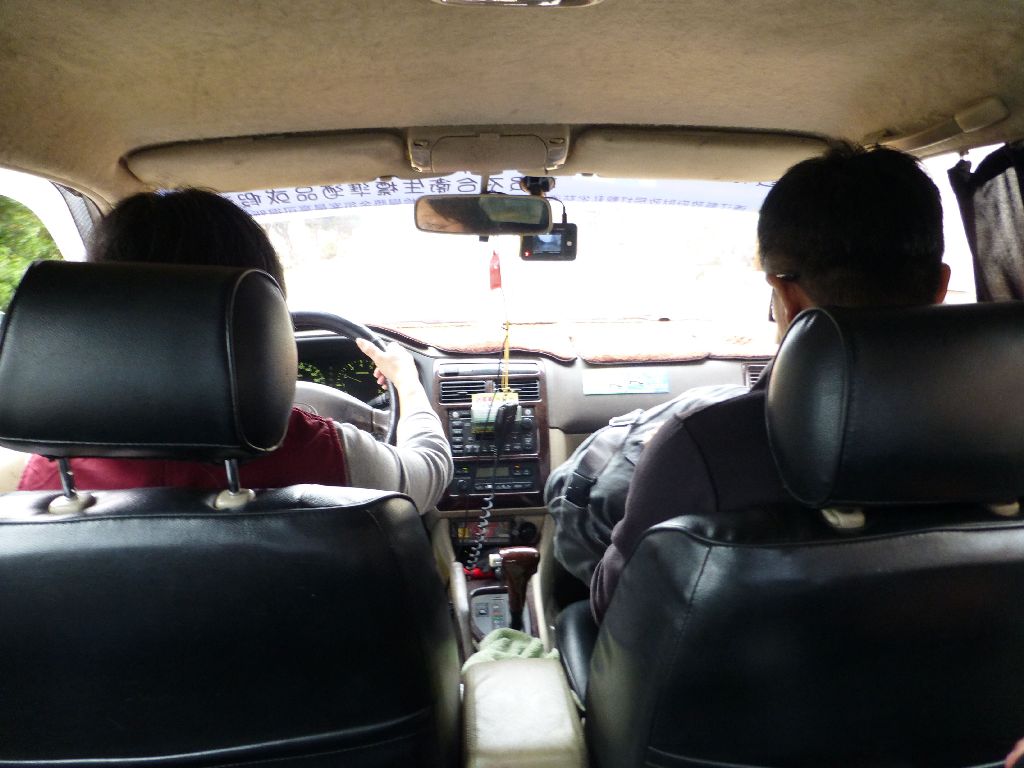
where the taxi driver did not linger: other customers are waiting at the airport.
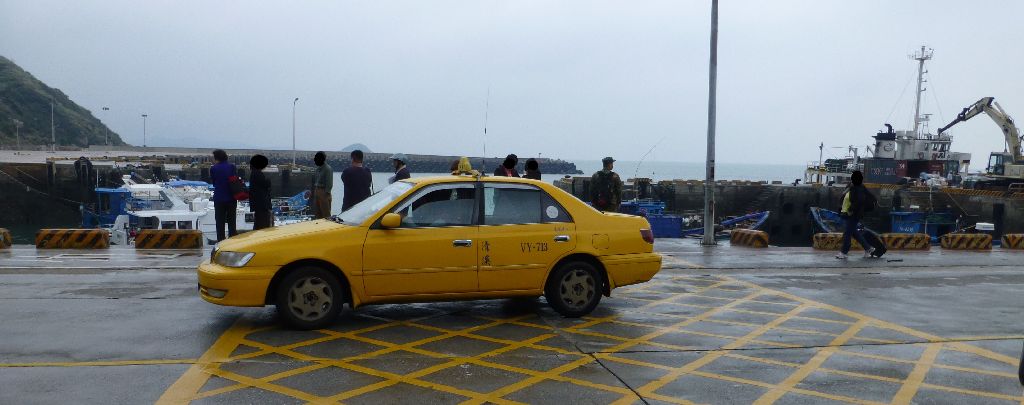
Buying two tickets for the intra-island ferry only took a couple minutes and we went down the stairs (note the high visibility orange uniform, worn by all the Taiwanese harbors' personnel).
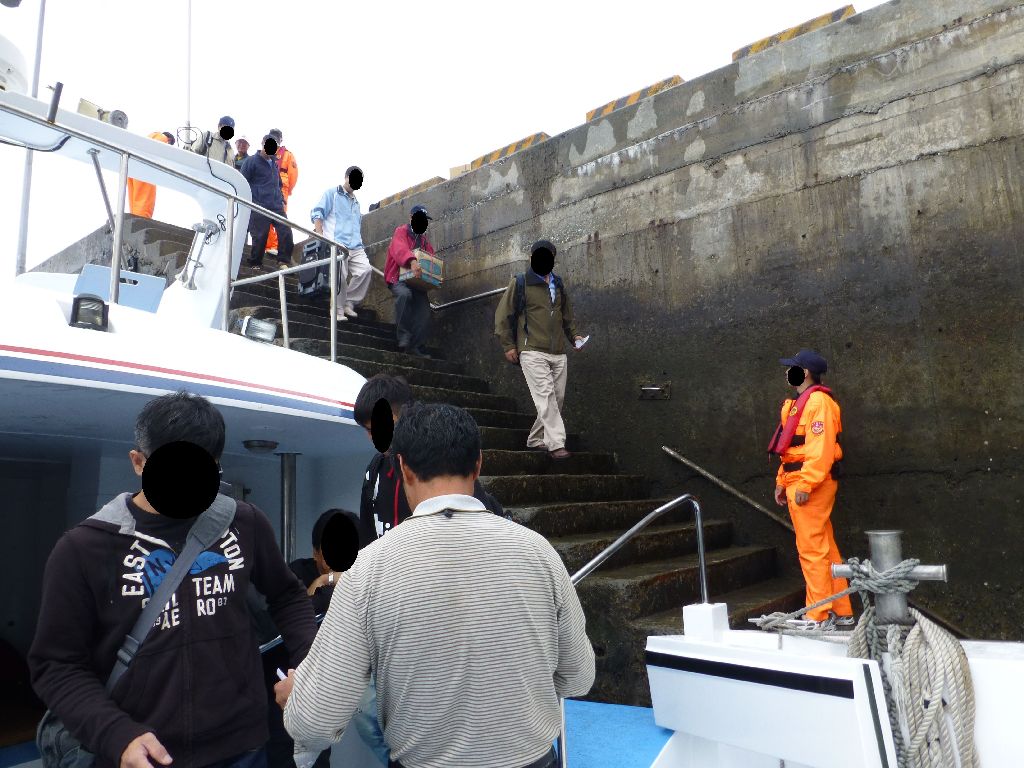
And off we went. We had just made it on this ferry, and there was only one per hour.
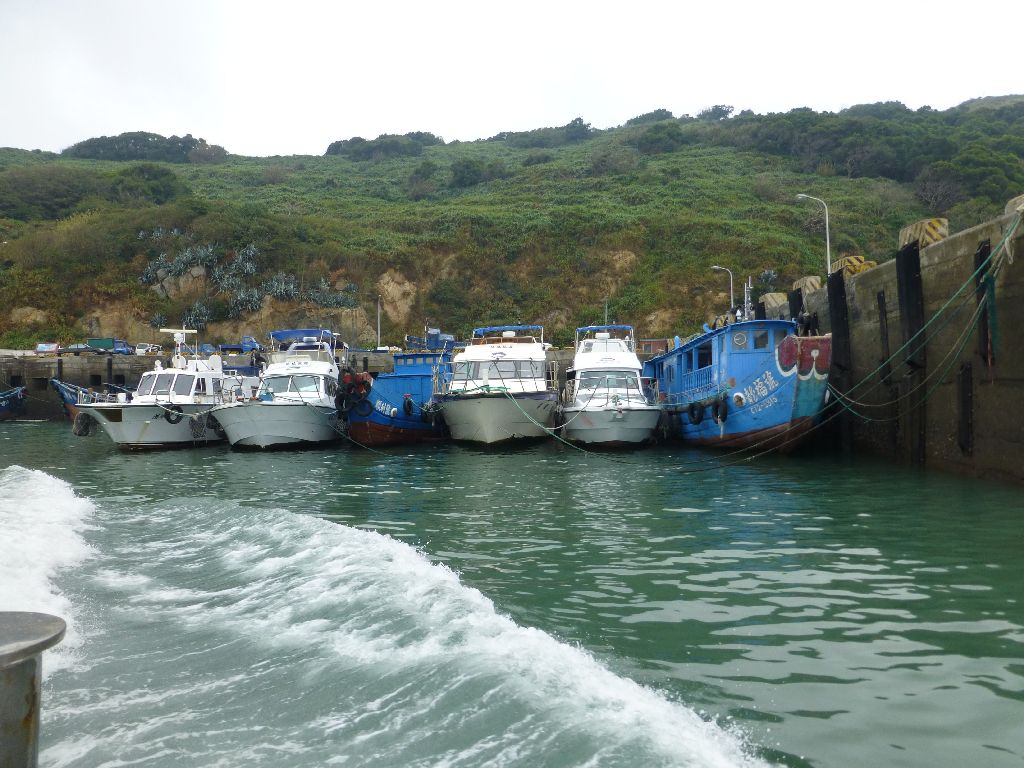
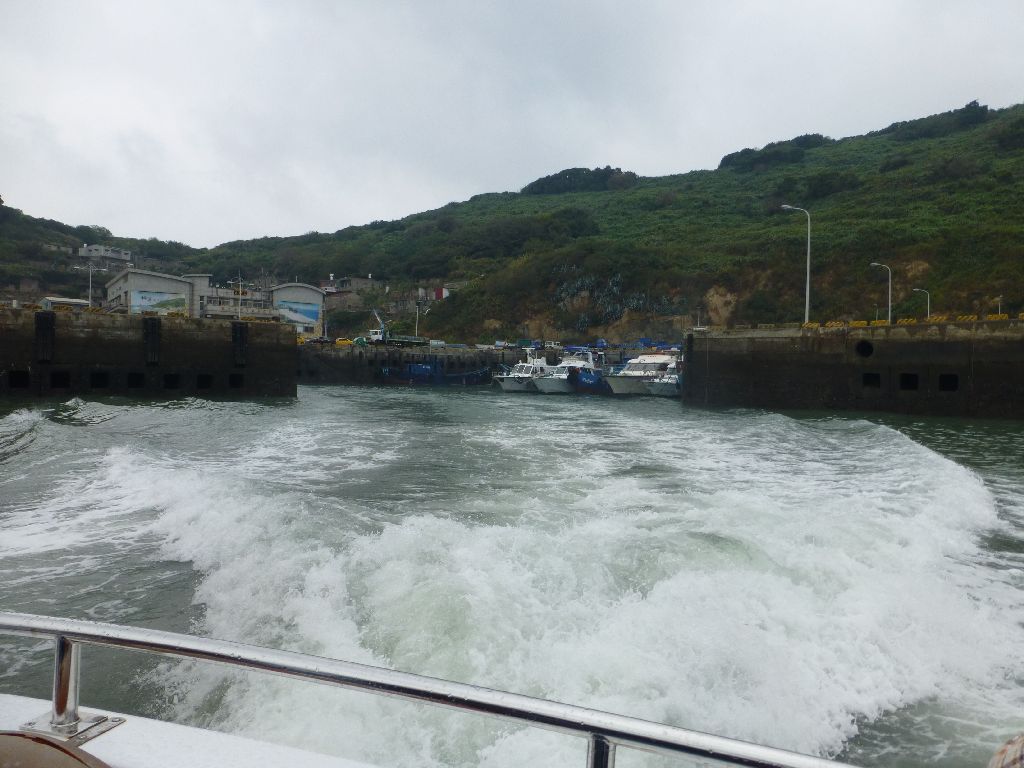
An unusual picture of a luggage with an airline tag together with a lifebuoy.

But what would a FR by Marathon without a reference to Hello Kitty ?

In the distance, it's Nangan, where the weather was even worse than in Beigan.
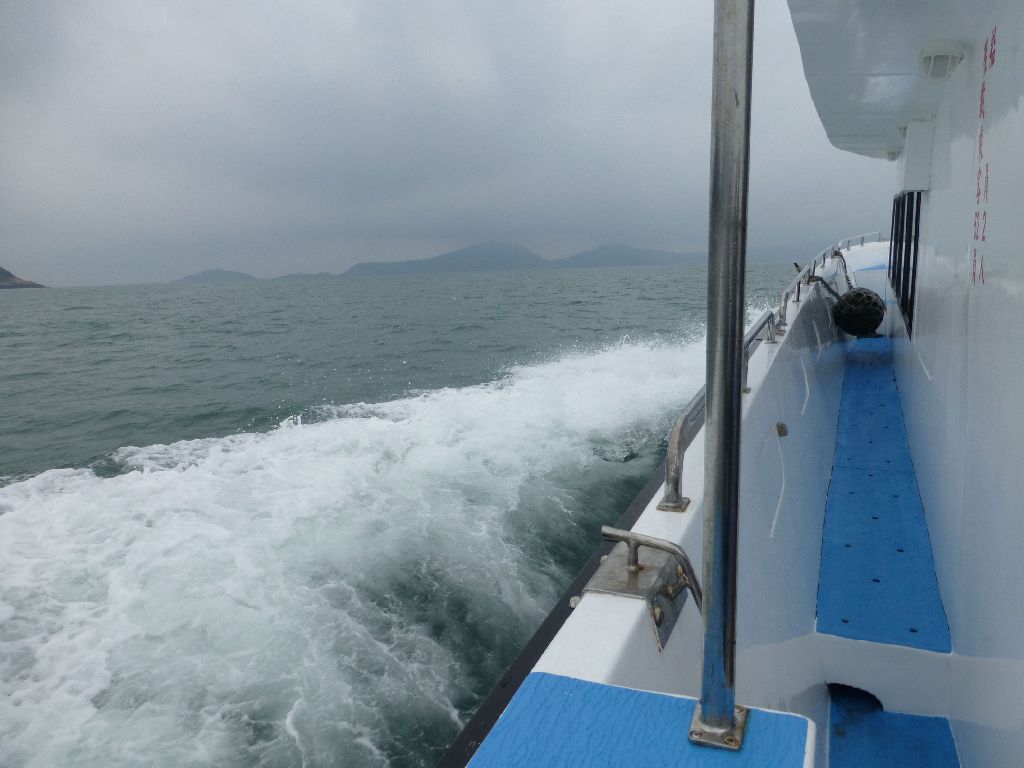
By the way, seating in the cabin is 3+3 in the rear
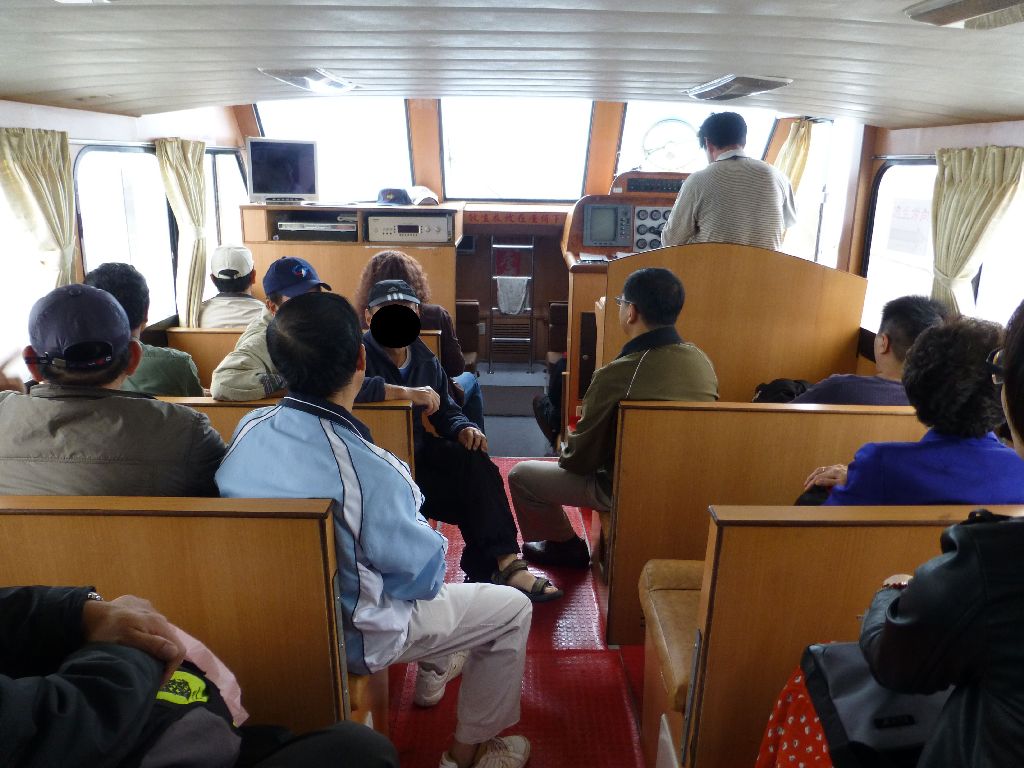
And beyond a few steps, there is a business class lounge under the roof (actually, there is no class on board)
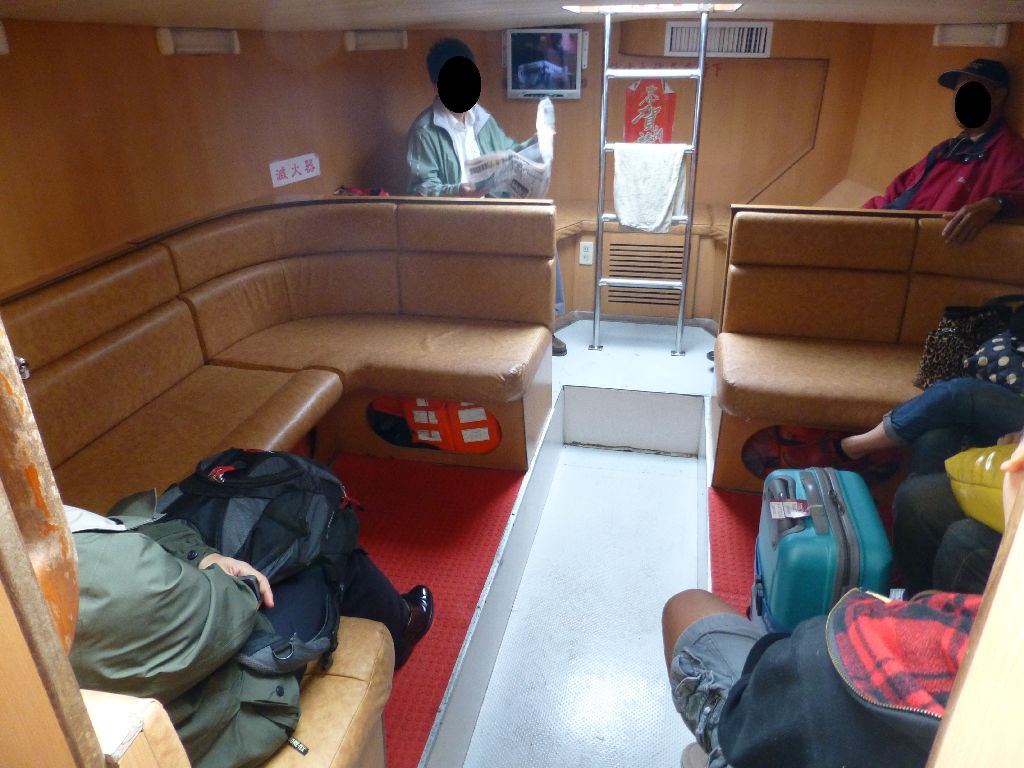
No IFE, food or drinks on board, for free or for pay.
We were reaching here Fu'ao, the main harbor of the archipelago. In the distance, on the right, it is the famous Sleep on spears while waiting for dawn giant motto, a reminder of the time when Matsu was on the front line between Taiwan and Mainland China, only 25 km from the enemy. In the foreground, a Taiwanese Coast guard ship was leaving on patrol.
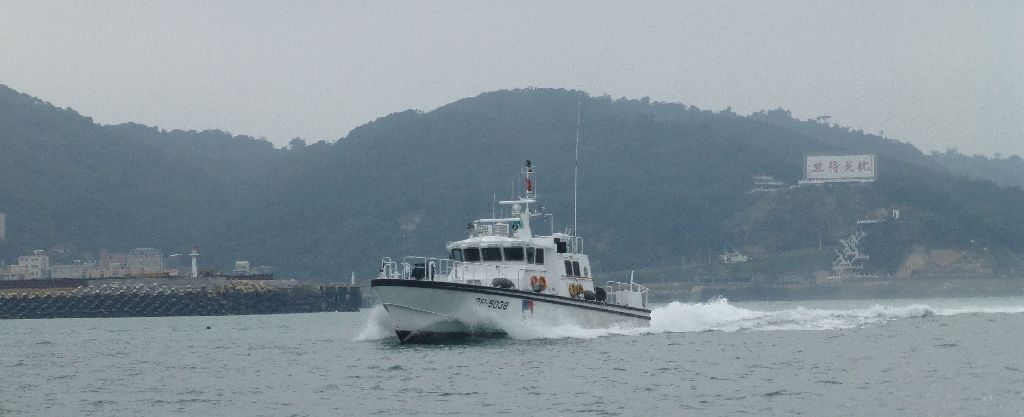

Arrival in Fu'ao
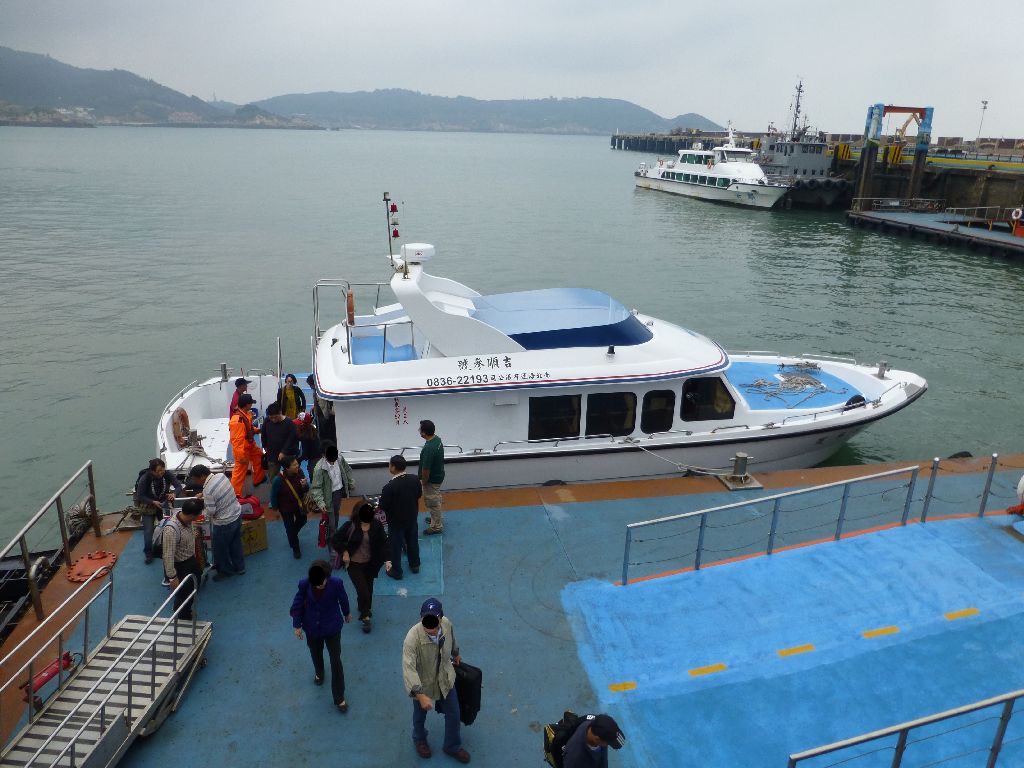
Once disembarked in Fu'ao, we only had a short taxi ride over the hill to reach Jieshou, the tiny main town of these islands. We arrived only one hour later than expected at the B&B that I had booked, which was negligible compared to the two days that I had scheduled for showing these two islands to my wife.
The B&B where Leadership had seen me reserve a room without even checking it did not look nice from outside, but the room was up to my expectations. In which 4* hotels do you have two computers connected to the internet per room?
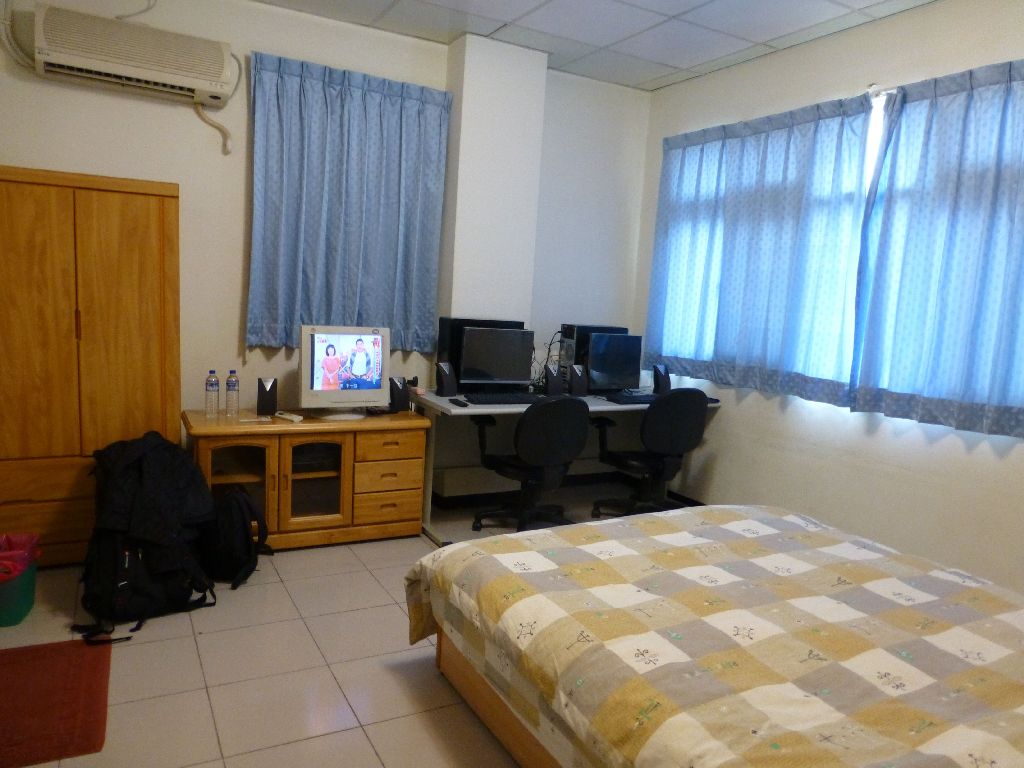
In front, this nationalist painting, where the lighthouse of Taiwan shines upon Mainland China, with the motto Unification of China under the Three Principles, often translated for short by Government of the people, by the people, for the people: these are the democratic principles set by Sun Yat-Sen when he founded the Republic in China in 1911.
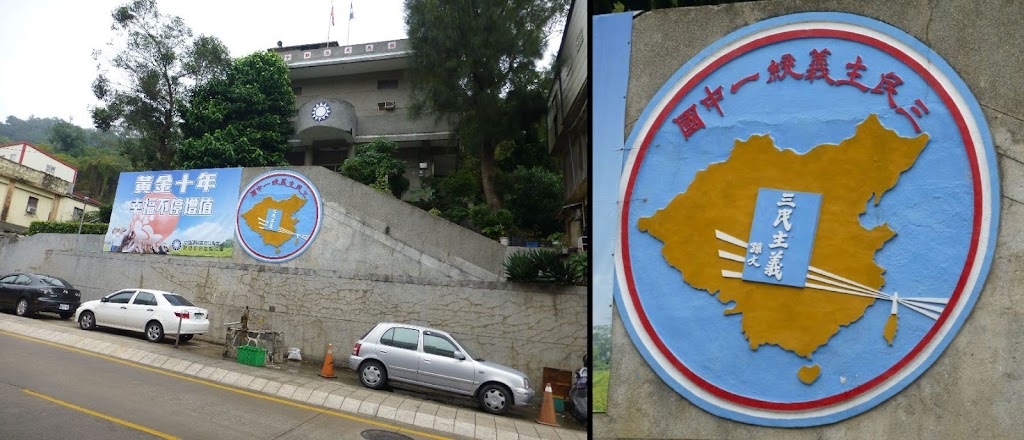
This FR ends at the empty LZN airport
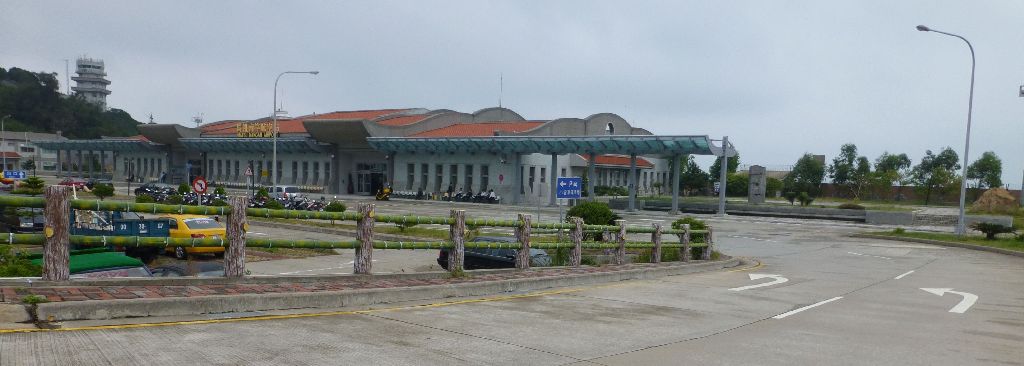
… and its equally empty view point on the tarmac and the runway
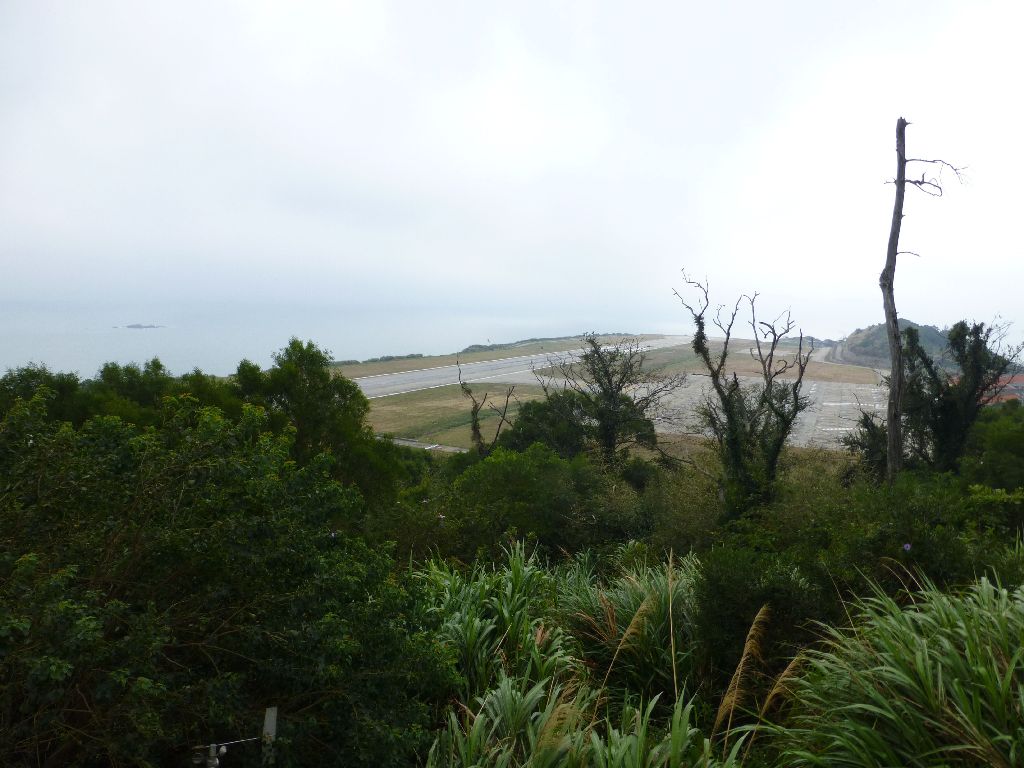
Now that we have reached LZN, this is the end of this FR, with the twin air and sea boarding cards
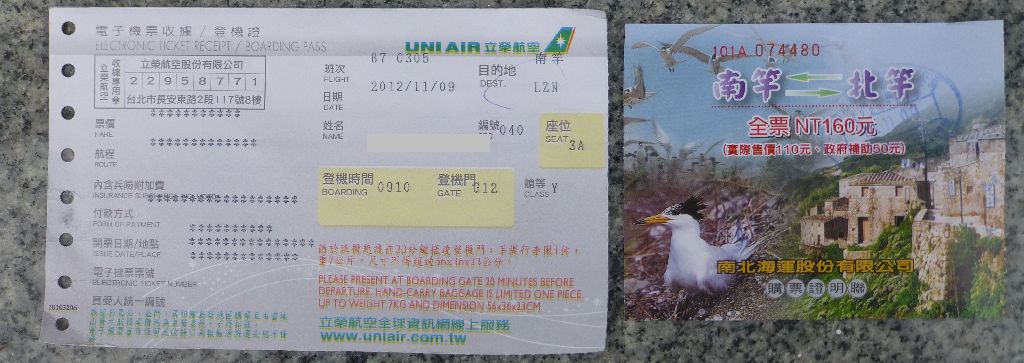
As a bonus, this is what plane spotting in LZN looks like, when you can land there. This was during my day trip with Leadership two weeks earlier.
On the right, the end of the runway; the Taiwanese have built the turnback area on concrete pillars. You can see the scooter which I had rented for the day.
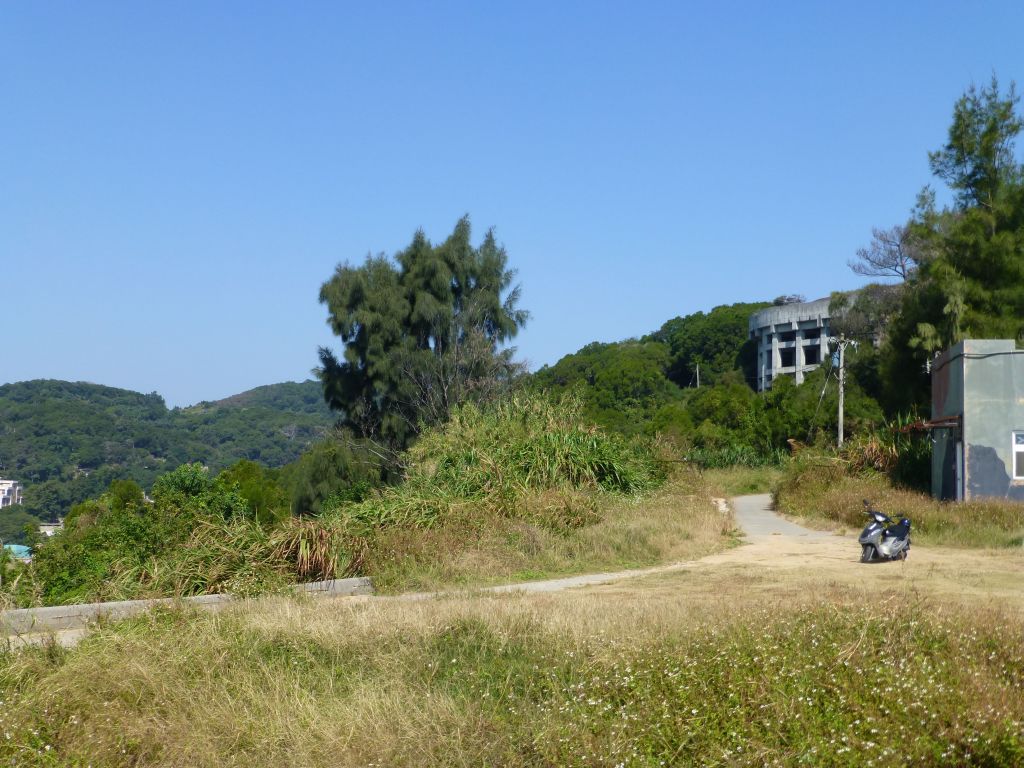
The Dash 8-300 approaches: it is the same B-15237 which we boarded on the way in and out that day.
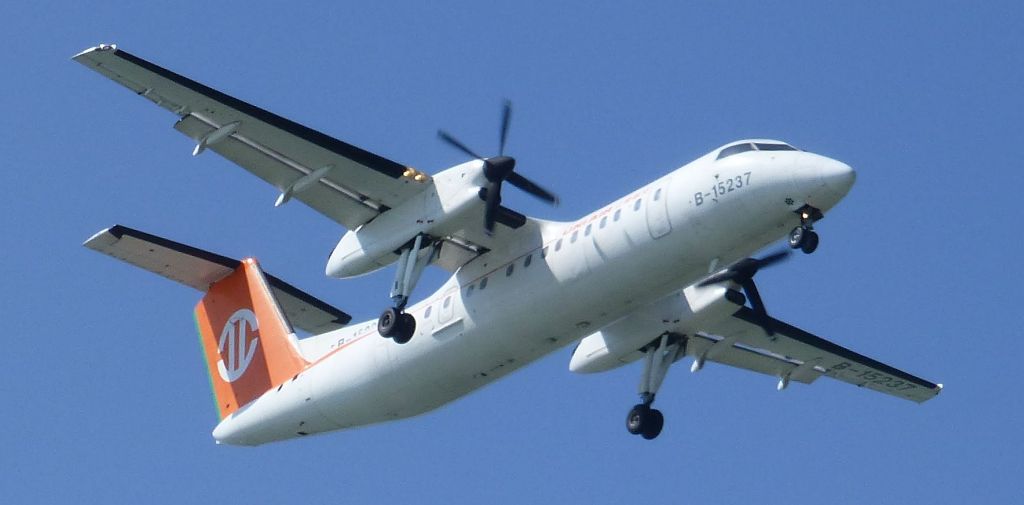
There it is in front of the terminal with the control tower in the distance.
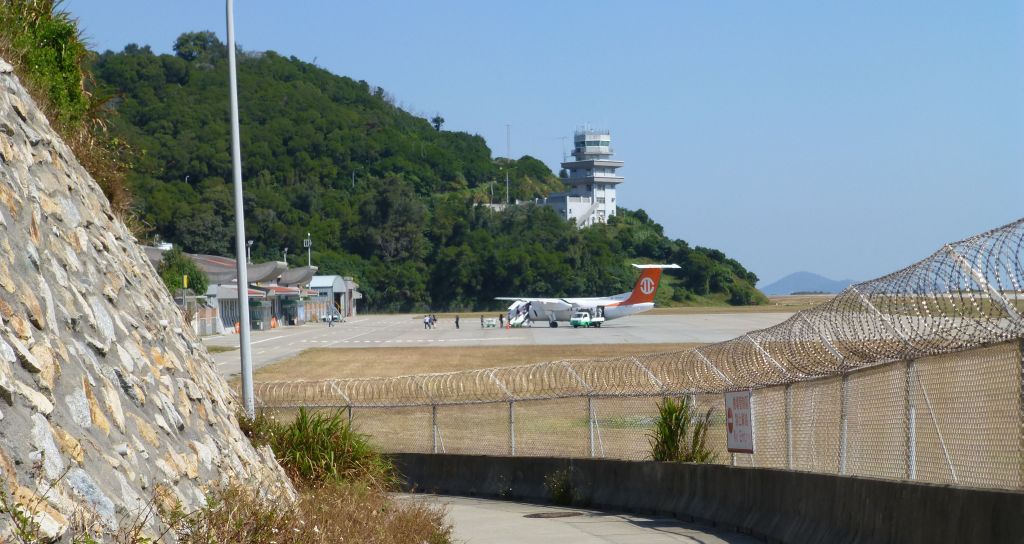
Another view from a location close to the control tower
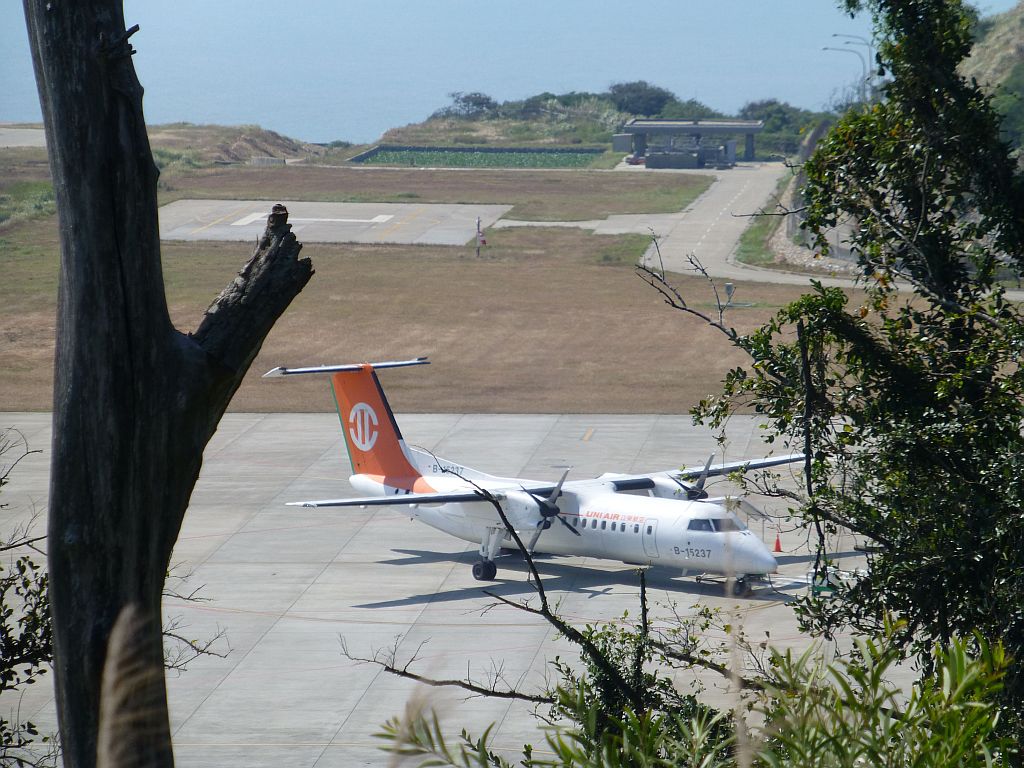
The plane taxies up the runway
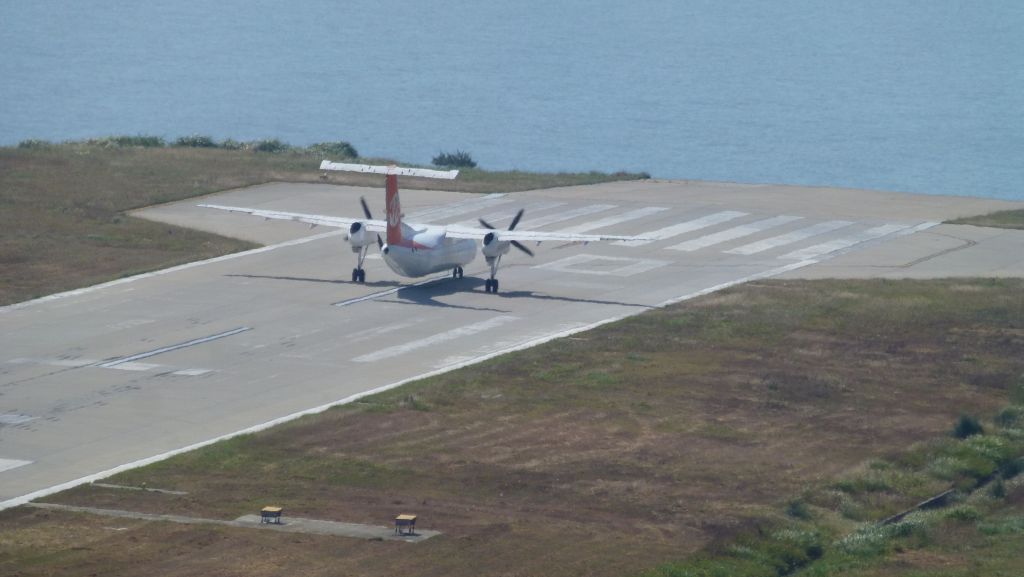
Turns back at the runway's extremity
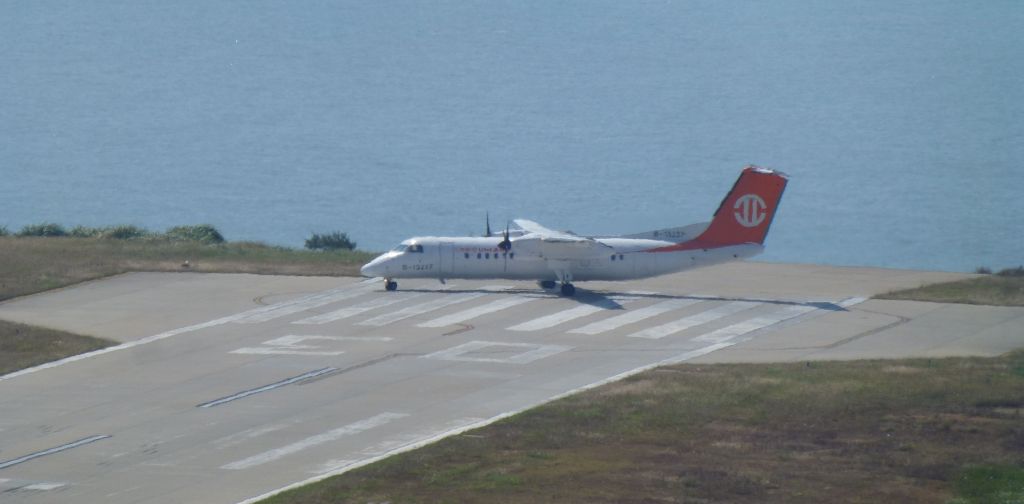
Picks up speed,
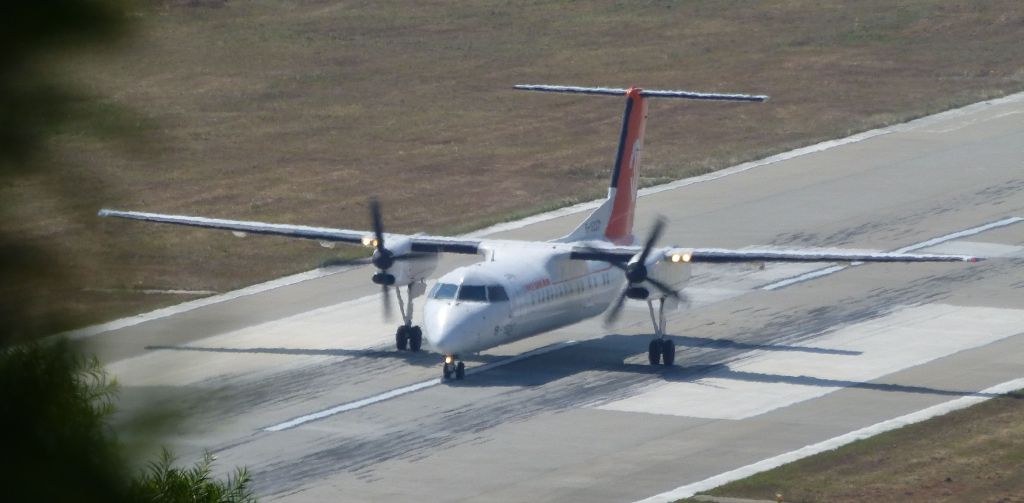
And takes off, in parallel to its shadow
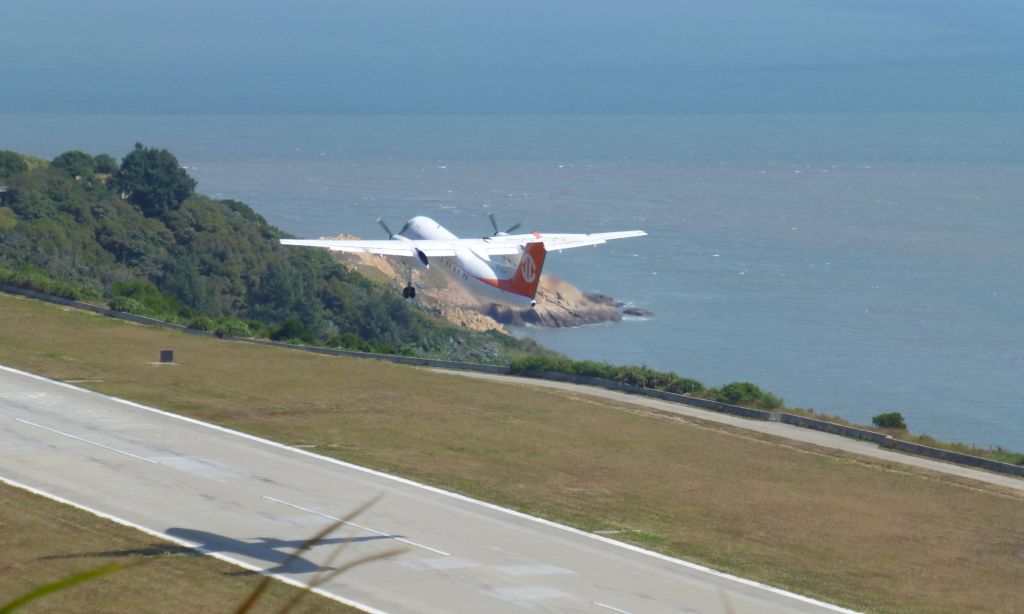
In the distance, Beigan, with MFK just above the second branch of the tree.

As a bonus of the bonus, this is the Beihai underground naval base, carved with crude tooling in hard rock, in order to shelter the fleet of speedboats, landing and resupply ships from Mainland China's bombings. At low tide, it is even more James Bond-like, because you can walk alongside the entire length of the tunnels.
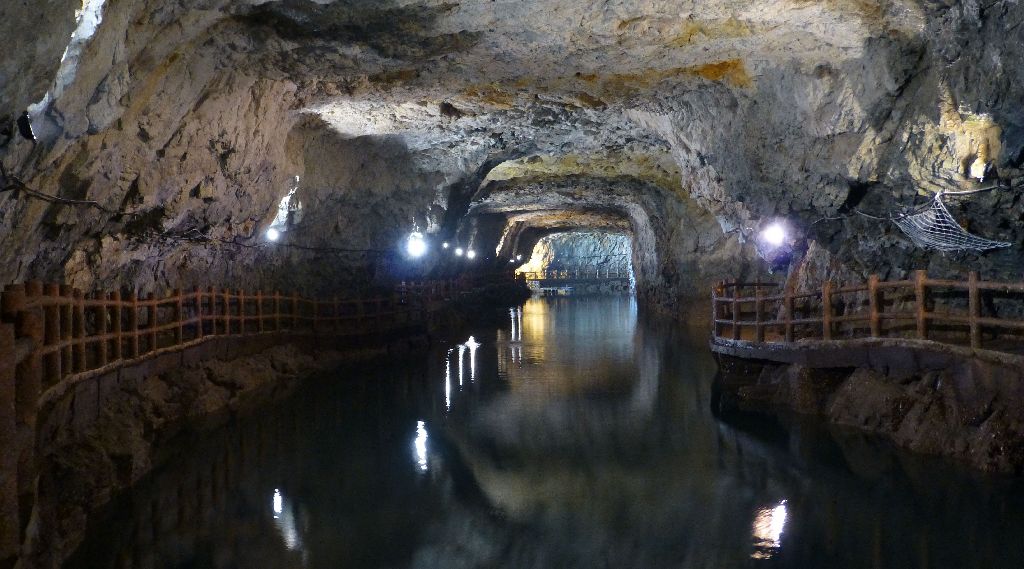
And this small fort protected the Jinshan harbor, decorated with these slogans:
- Iron blood
- Win against the communists
- Resist Russia
- Kill Zhu De (the highest ranked Chinese general)
- remove Mao Zedong
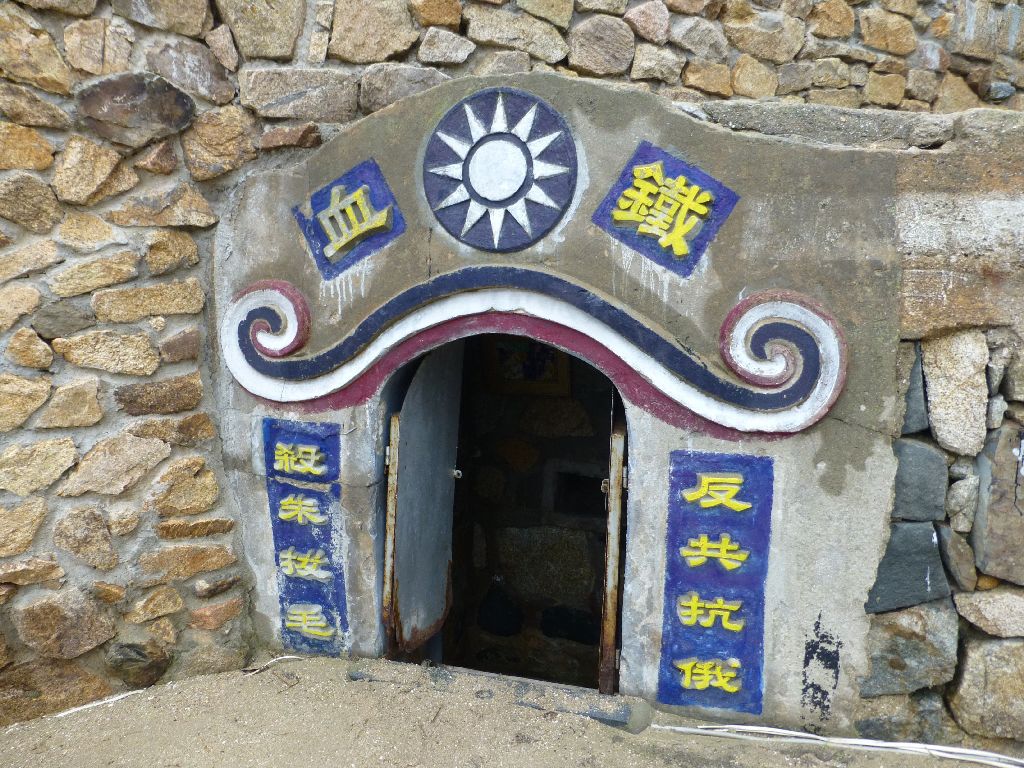
To sum it all, it was a great flight to LZN and MFK.
Same player, shoot again : the flight back to TSA was just as much fun, and I let you guess what happened before finding the solution in the FR of the return flight.
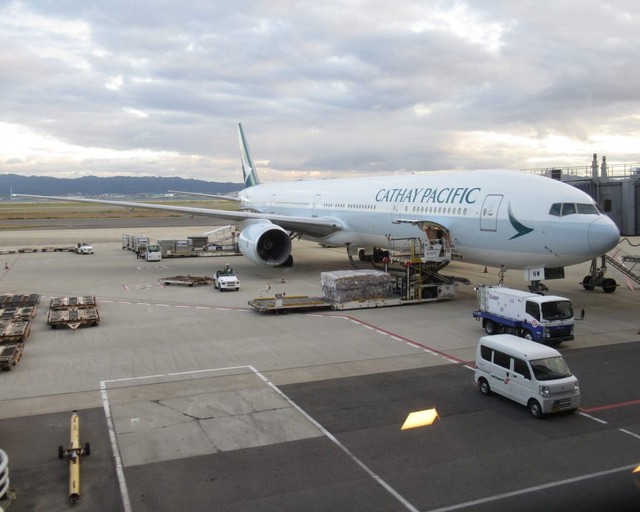
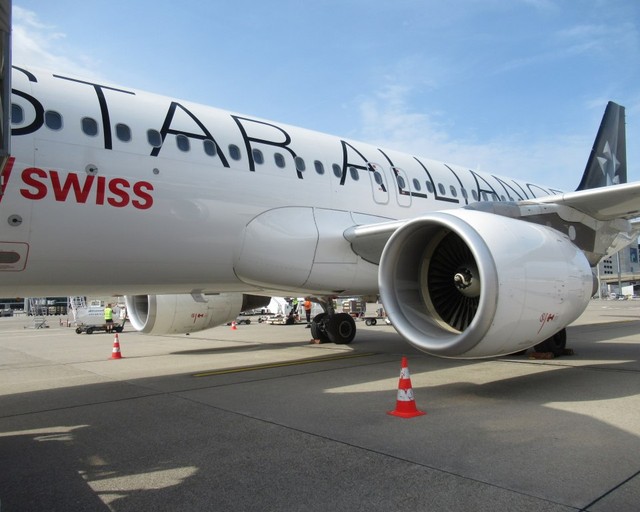
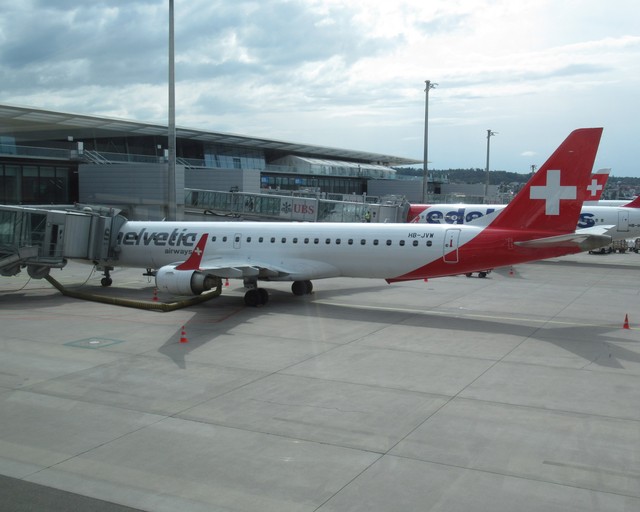
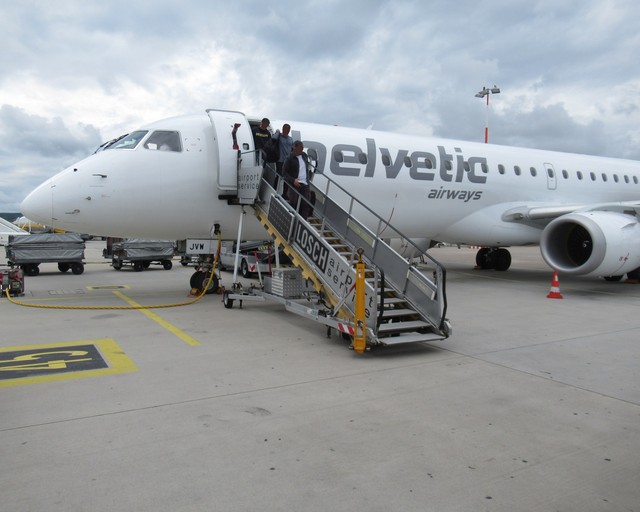
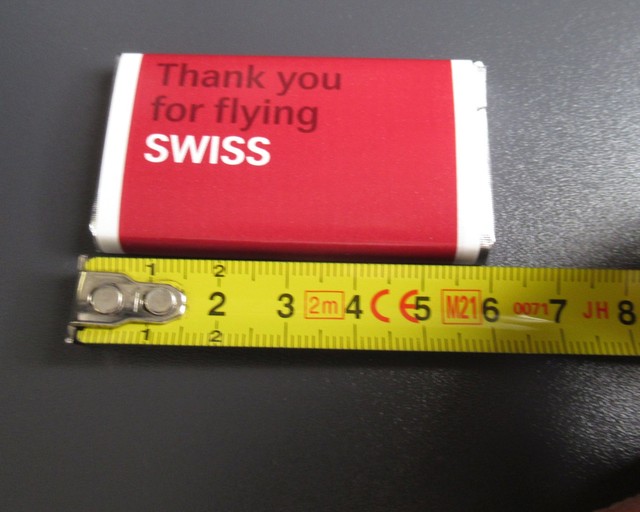
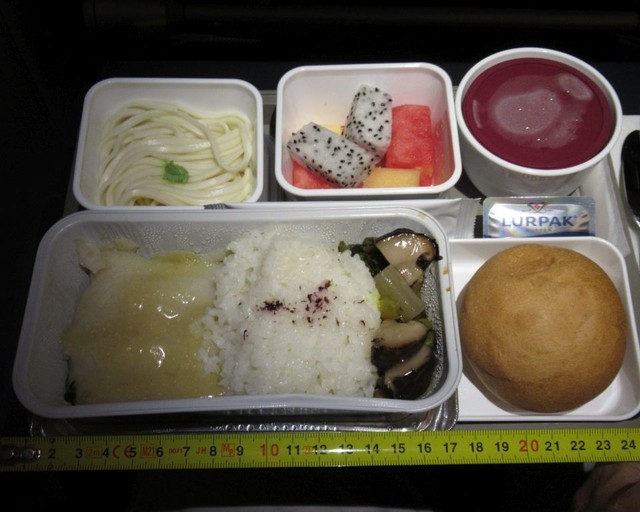

A short but eventful flight! It is really surprising that they just landed at another airport entirely and then expect you to just figure out how to get where you need to be. Most airlines will divert a flight for safety/weather but then transport pax to their final destination either with the original plane when it is able to leave or arrange ground transportation. I'm glad that you enjoyed this misadventure and were able to take it in stride, I don't think I'd be as happy about having to take a taxi and a boat after diverting to another airport, LOL.
Well, you never have non-Chinese speaking PAX on flights to these islands, so nobody was idling with the please help me attitude. The rerouting cost me 100 TWD / 2 (flat island taxi fare, shared with 2 other PAX) + 160 TWD x2 (intra-island ferry) : a total of 370 TWD, or less than 10 EUR. I had been to Matsu several times and I knew it would cost peanuts. Maybe Uni-Air would have arranged for the transfer, but I did not want to waste a couple hours for so little extra expense until a bus chartered at the last minute was arranged and made it to the harbour. Besides, it was much more fun that way ^^
Oh wow only 10EUR for all that? Than I get why it's not a big deal--I thought it would be much more than that to take a taxi and ferry. So all is well that ends well.
Thanks for the fun and exotic report!